The UGREEN DH4300 PLUS NAS Review – Good Value?
The UGREEN DH4300 Plus is a 4-bay NAS solution introduced quietly into the company’s growing lineup of storage devices, appearing online without the usual fanfare. Closely related to the DH4300 Plus in both hardware and feature set, this model forms part of UGREEN’s value-tier NAS systems, designed to provide essential private cloud functionality at a lower cost. Targeted at home users, prosumers, and small offices, the DH4300 Plus offers a mix of modern storage capacity and lightweight computing through its ARM-based architecture. With support for RAID 0, 1, 5, 6, and 10, 2.5GbE networking, and up to 120TB of raw storage across four SATA bays, the device aims to provide a reasonably capable platform for tasks like file serving, multimedia streaming, and basic photo management.
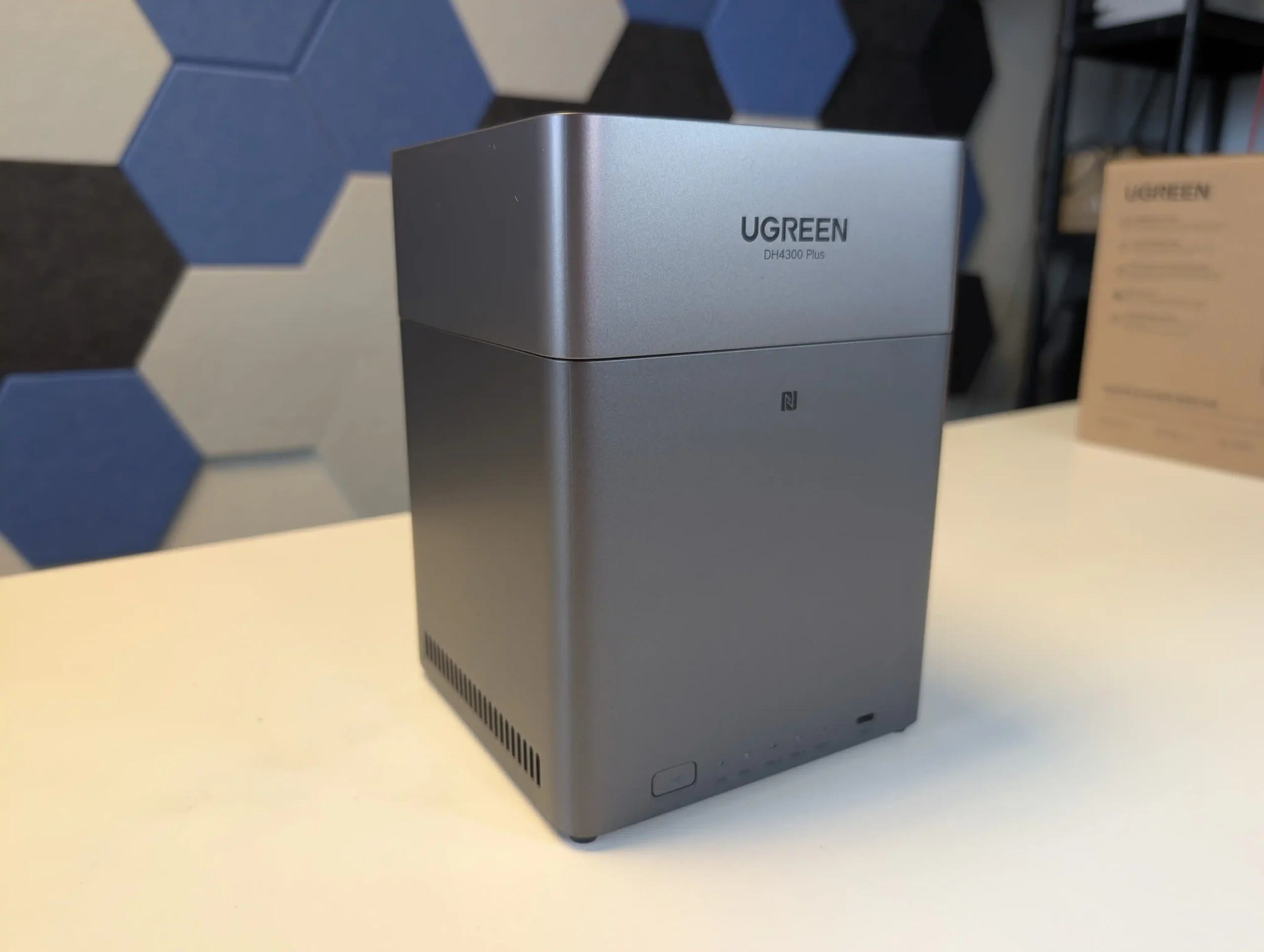
However, the DH4300 Plus doesn’t just follow the pattern of other budget NAS solutions. It includes features uncommon at this price point, such as HDMI output and 10Gbps USB connectivity, which extend its use case beyond simple backups into media and even light-duty AI-powered photo organization. Its system-on-chip, the Rockchip RK3588, is more powerful than the processors seen in comparable entry-level NAS systems from other brands like Synology or QNAP. While it lacks the high-end features of premium NAS units—such as multi-port networking or M.2 expansion—it still manages to deliver a compact, energy-efficient package suited to most daily NAS workloads. This review breaks down each component of the DH4300 Plus, from its physical design and internal hardware to its software ecosystem, to help users decide whether this is the right solution for their needs.
UGREEN DH4300 NAS Review – Quick Conclusion
The UGREEN DH4300 Plus stands out as a well-equipped entry-level NAS that offers considerably more than its modest price tag suggests, positioning itself as a serious contender in the growing value NAS market. Powered by the RK3588 ARM processor and backed by 8GB of LPDDR4X memory, it delivers capable performance for a wide range of NAS tasks including file sharing, media streaming, light containerization via Docker, and AI-assisted photo management. Its support for 2.5GbE networking, 10Gbps USB ports, and HDMI 2.1 output adds versatility, enabling faster-than-Gigabit transfer speeds and options for direct media playback or on-site display access. The system’s low power consumption, compact footprint, and quiet operation make it especially well-suited for 24/7 deployment in home or small office environments. AI functionality for face recognition and album generation, powered by the on-chip NPU, further enhances its value for users managing large personal photo or media libraries. However, the device is limited by its lack of PCIe or M.2 expansion, absence of link aggregation or redundant LAN, and the relatively immature UGOS Pro software, which trails behind DSM and QTS in terms of advanced features, third-party app support, and overall refinement. Still, for users seeking a reliable, efficient, and feature-packed NAS at a competitive price, the DH4300 Plus represents a compelling option that punches well above its weight—offering core functionality, multimedia capabilities, and surprising hardware strength without venturing into high-end NAS pricing territory.
| Buy the UGREEN DH4300 on Amazon @409 | Buy the UGREEN DH4300 on UGREEN.COM | Buy the UGREEN DH4300 on B&H |
 |

|
 |
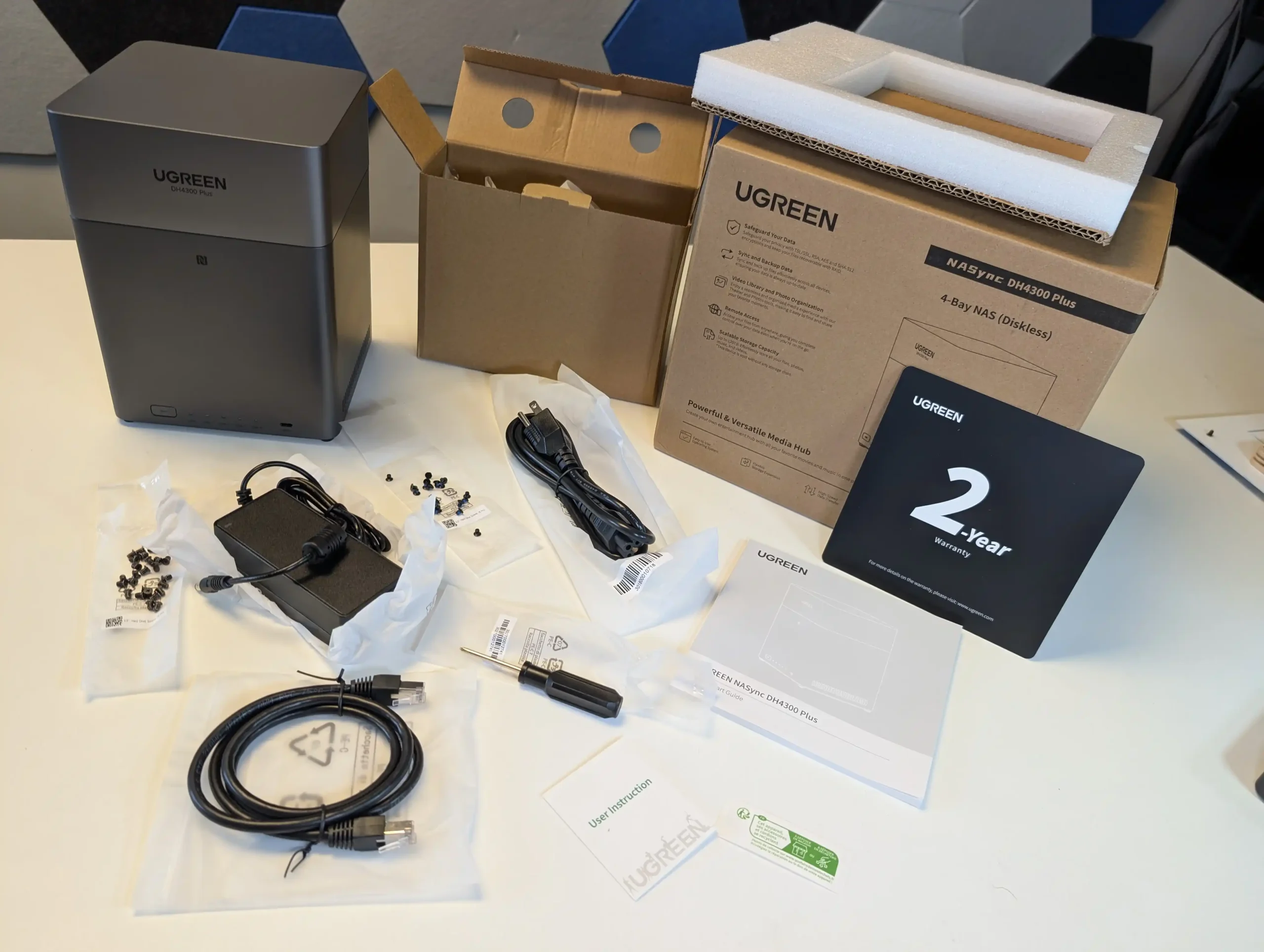
UGREEN DH4300 NAS Review – Design and Storage
The UGREEN DH4300 Plus adopts a minimalist, vertical chassis design that blends functional cooling with a relatively compact footprint. Measuring 155mm x 155mm x 215.7mm, the enclosure is tall and narrow, allowing it to accommodate four internal 3.5″ or 2.5″ SATA drives without consuming significant desk space. Instead of traditional hot-swappable trays, UGREEN uses a toolless drive insertion mechanism where each drive slides vertically into the chassis.
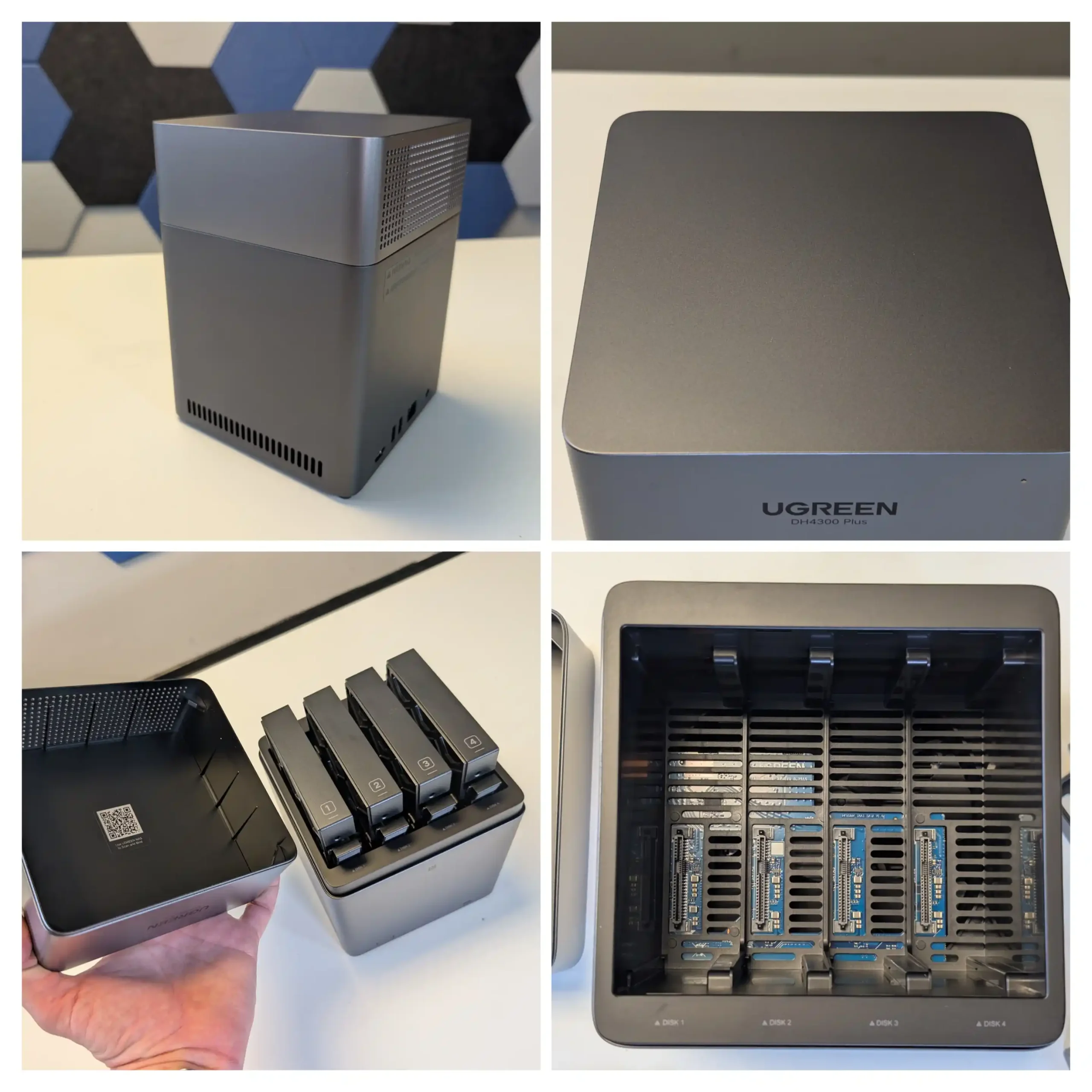
This approach reduces complexity and keeps production costs lower but introduces compromises in terms of drive handling and vibration isolation. The top panel is removable and held magnetically, granting access to the internal drive bays and initial setup QR code sticker located inside the lid. Ventilation is handled by side vents, perforations at the top of the cover, and a single downward-facing internal fan near the system board.
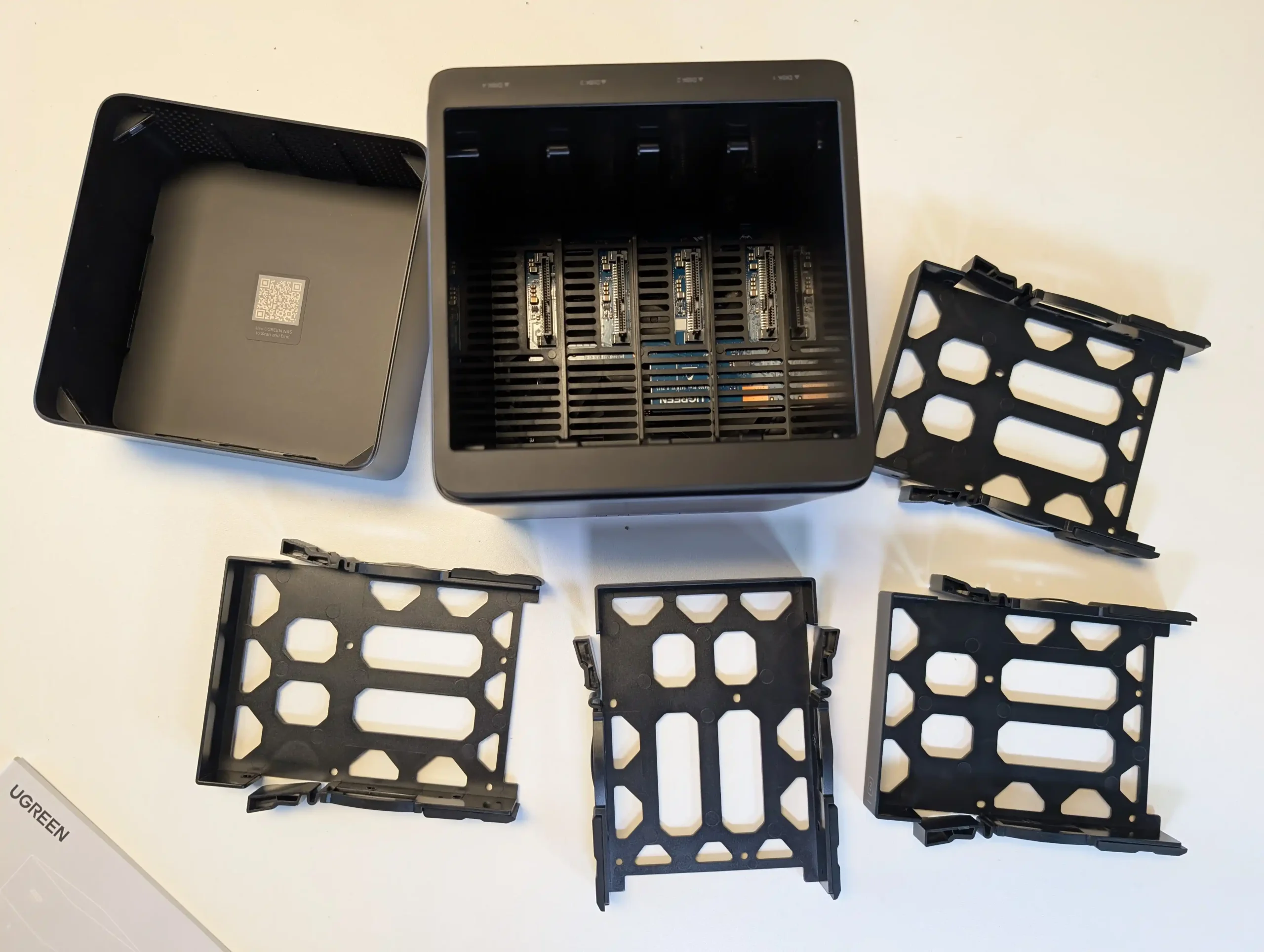
Drive installation is simple but not entirely refined. Each of the four bays inside feeds directly into a fixed SATA backplane. Drives are inserted vertically without caddies and seat against rubber bumpers at the rear, which help reduce some of the mechanical vibration but do not provide the same structural integrity or thermal separation found in more traditional hot swap and more easily accessible tray-based designs.
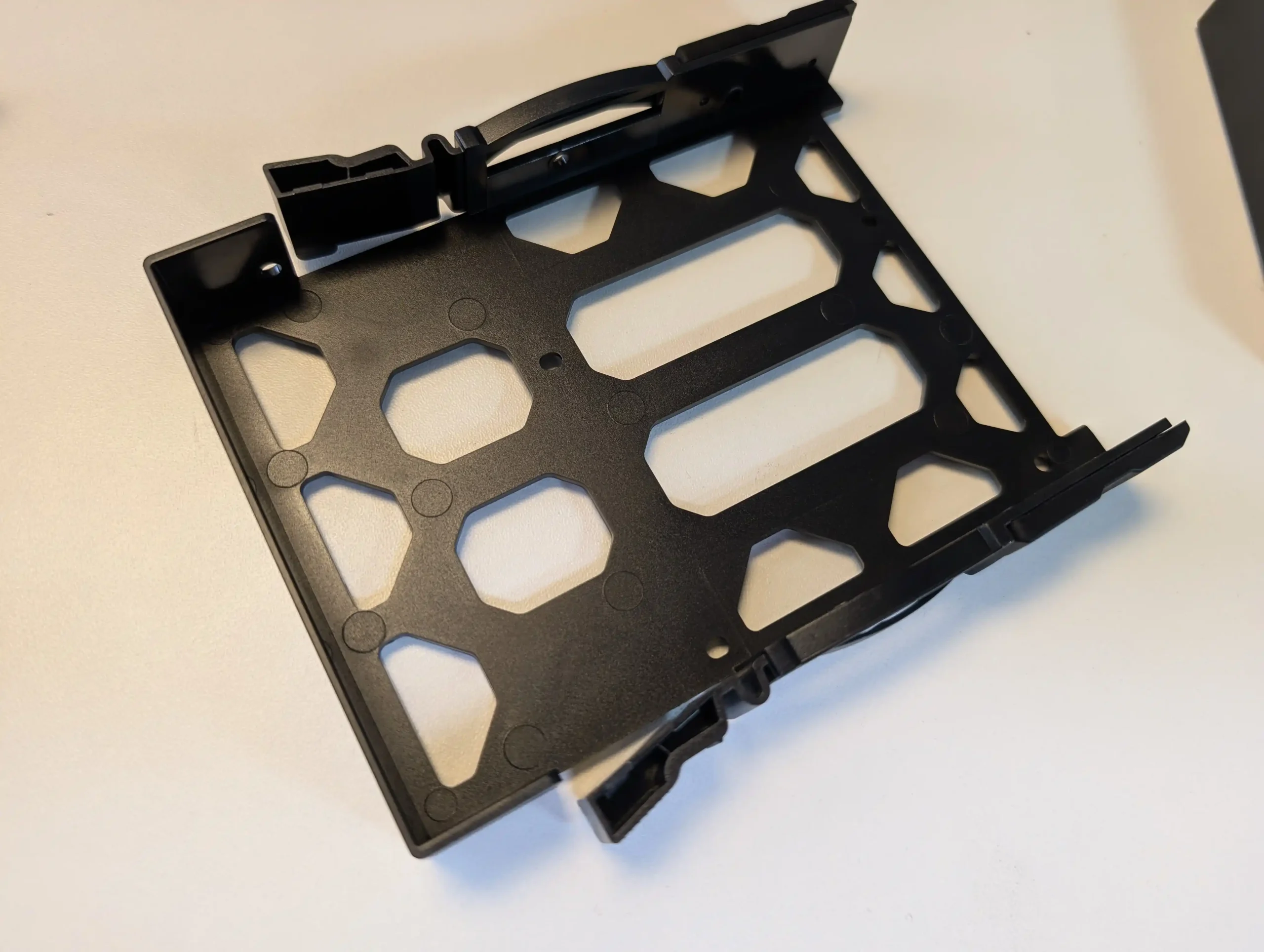
The plastic inner rails feel light and somewhat fragile, especially when compared to metal-based bays found in more premium NAS models. Still, the internal structure was found to be sufficient during testing, even when populating the system with higher-capacity drives. The unit officially supports up to 4 x 30TB drives, allowing a total storage capacity of 120TB in JBOD or RAID configurations, though users will need to supply their own disks as none are included in the package.
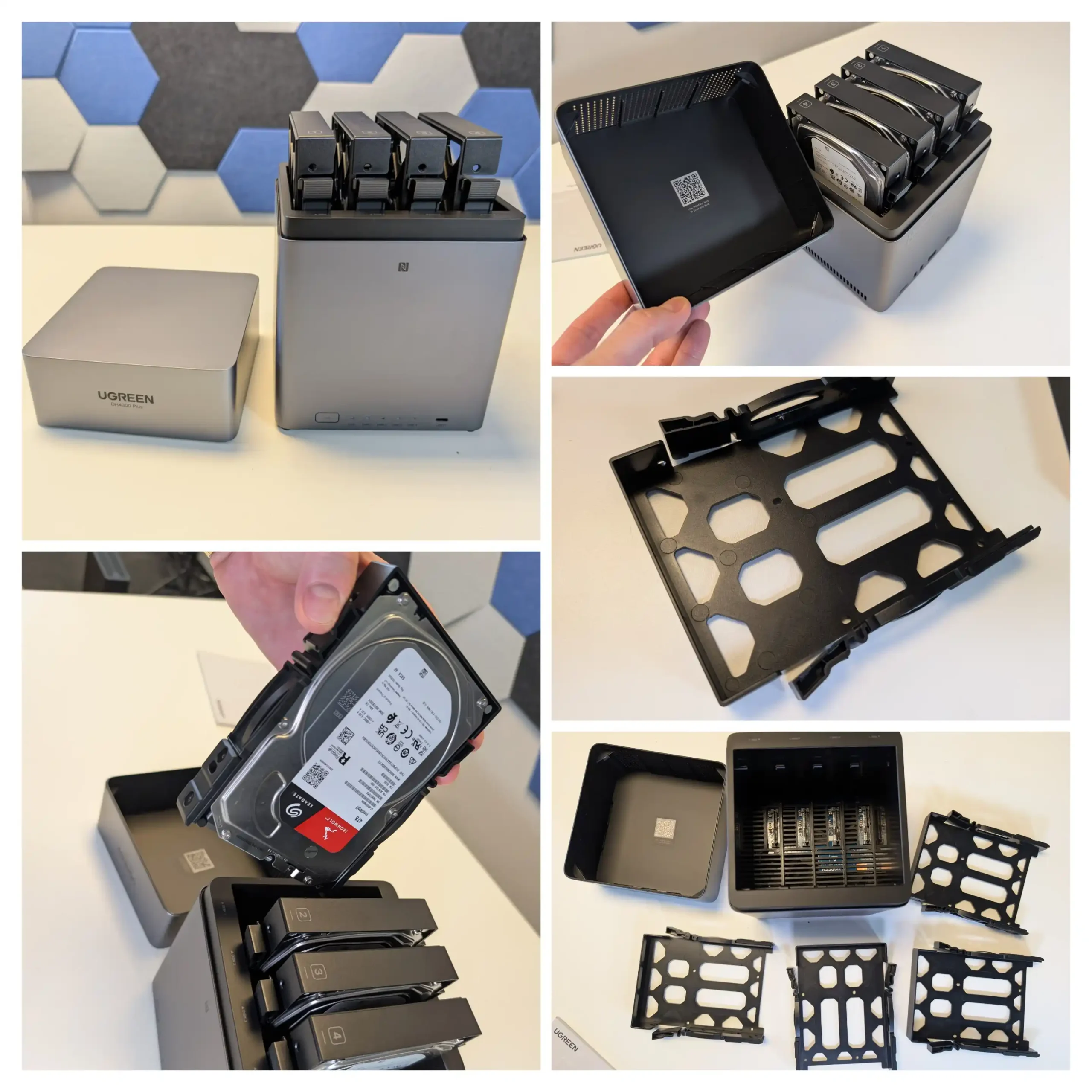
Airflow and thermal behavior of the DH4300 Plus are managed via passive intake vents and a single active cooling fan positioned on the base of the chassis. This fan draws air from the top and sides of the NAS, passing it over the CPU and power delivery components before exhausting out the bottom. While this layout is thermally efficient for a low-power device like this, it lacks redundancy and doesn’t allow for custom fan curve profiles within UGOS Pro.
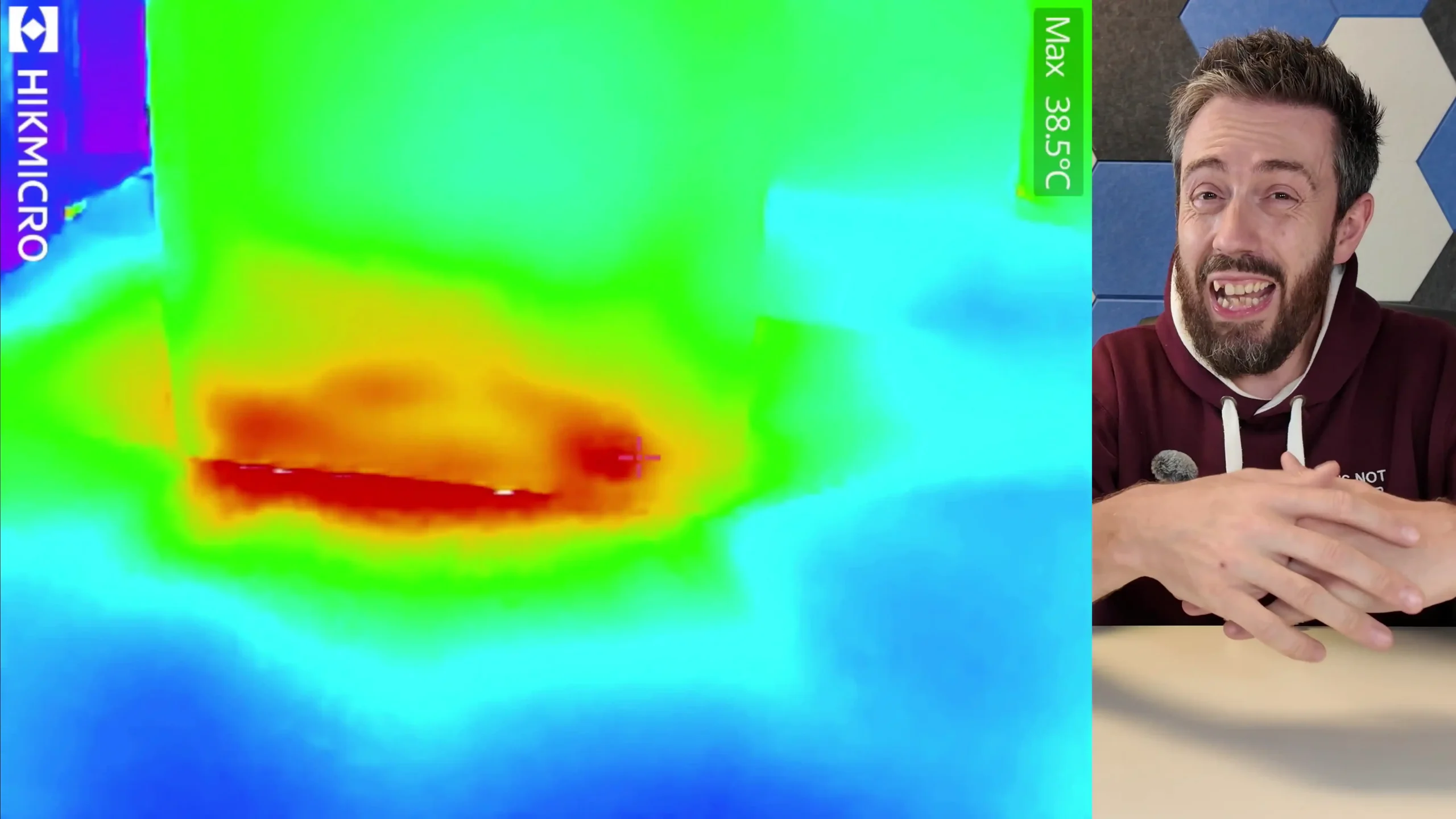 |
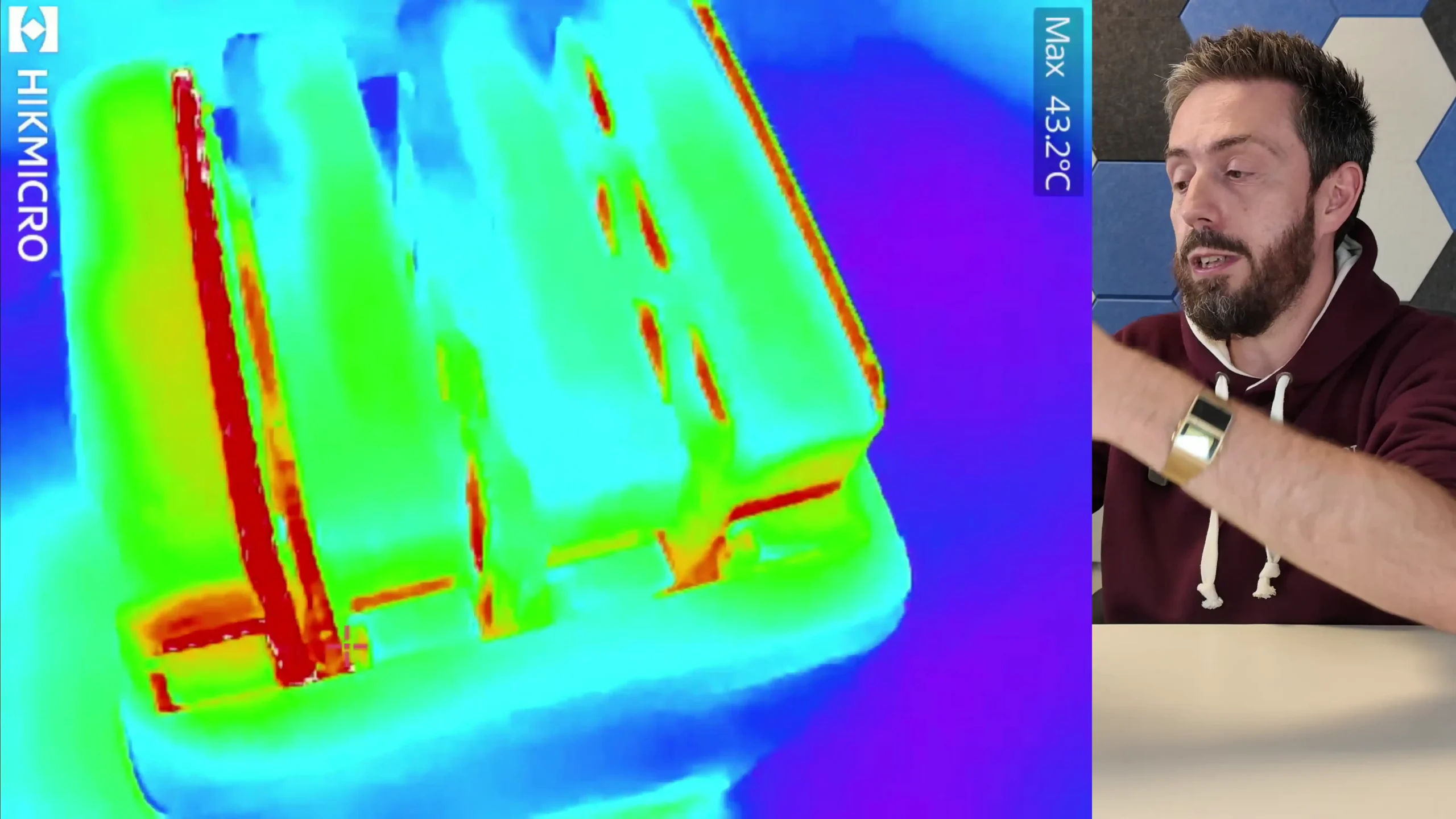 |
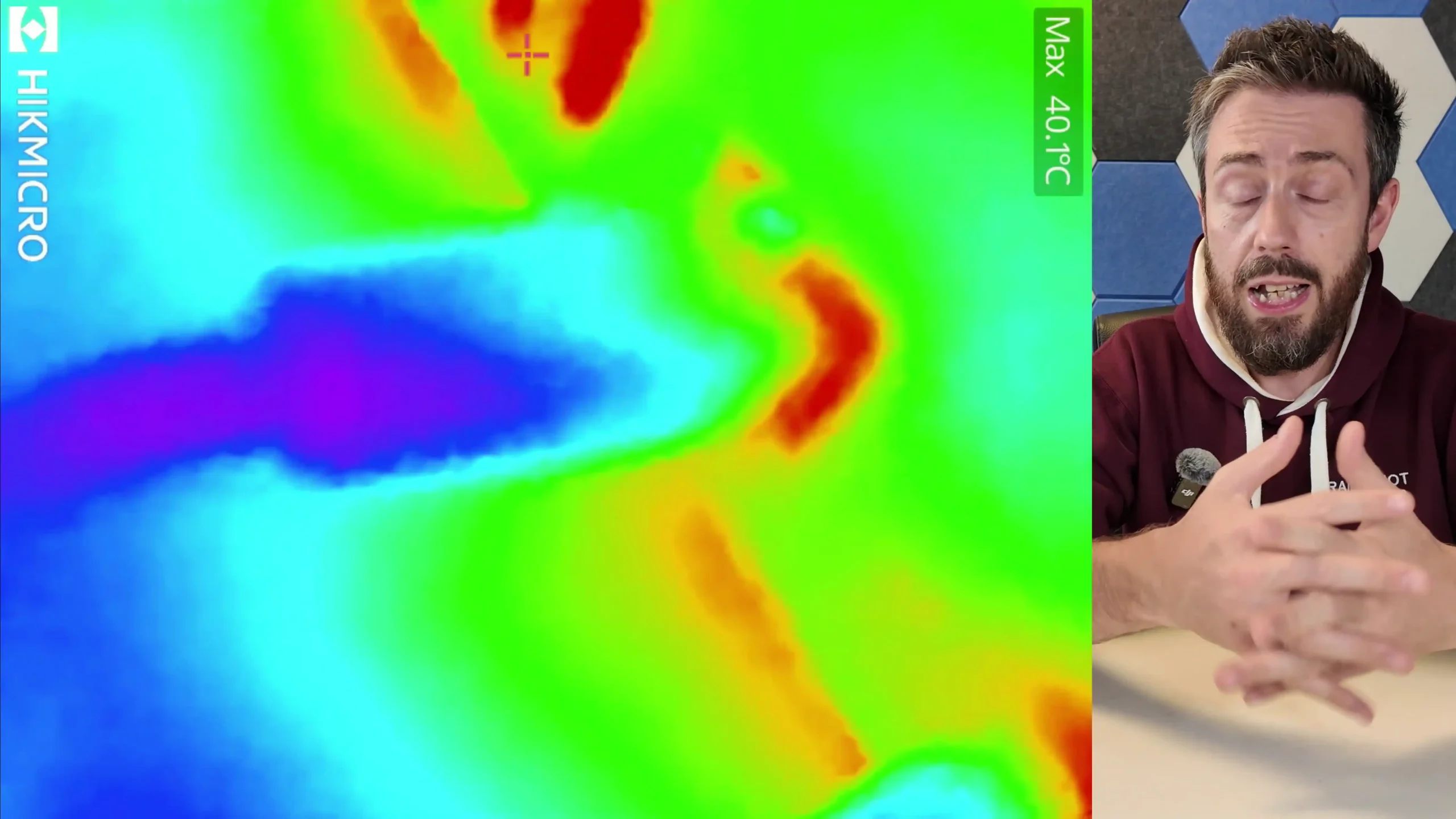 |
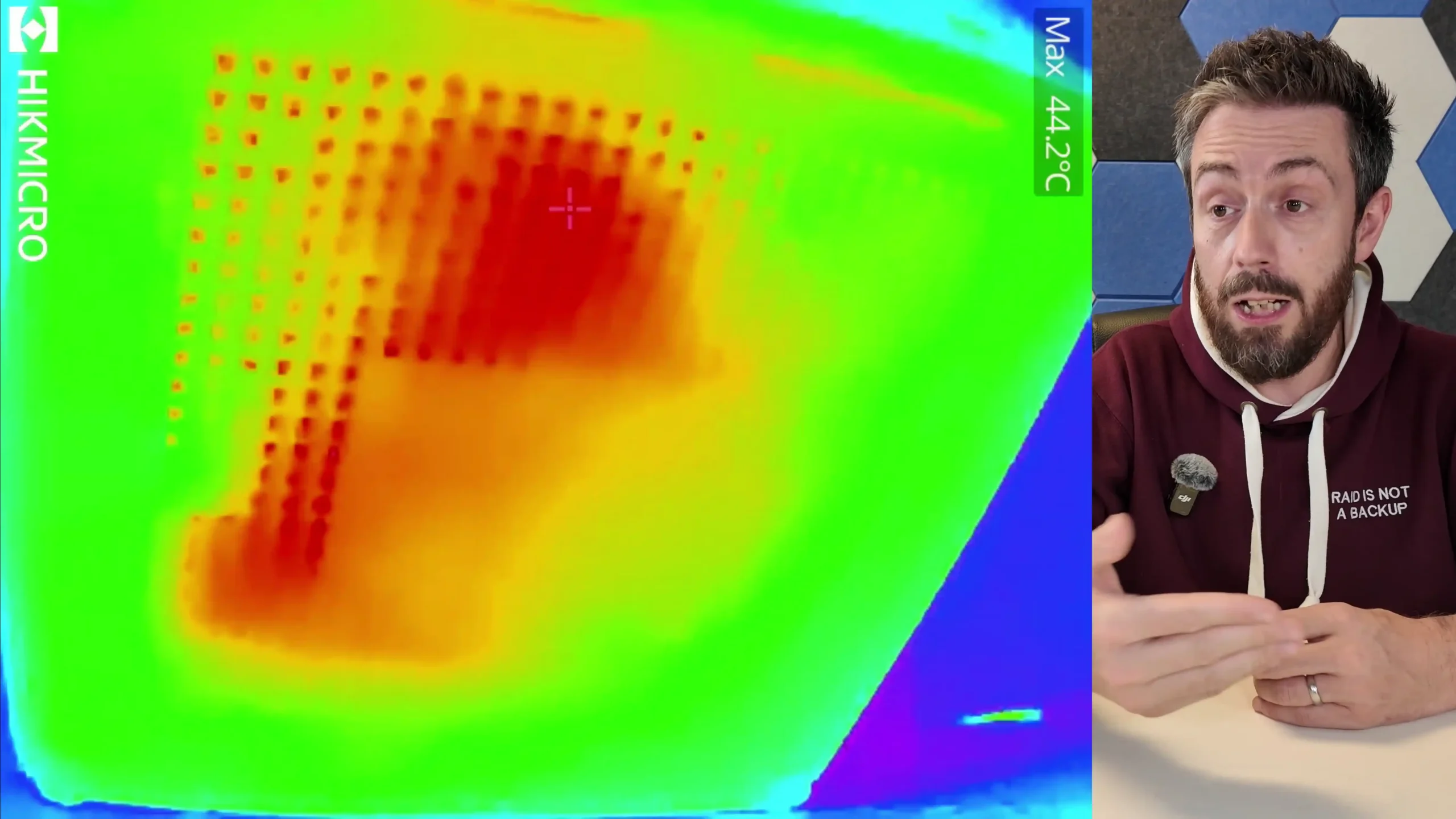 |
During 24-hour tests with four IronWolf drives installed, drive temperatures remained between 44°C and 45°C, while the system chassis and CPU areas stayed in the range of 38°C to 42°C under typical workloads. Though these temperatures are within operational thresholds, users deploying the NAS in warmer environments or fully populating it with high-RPM drives may need to consider ambient airflow or active external cooling assistance.
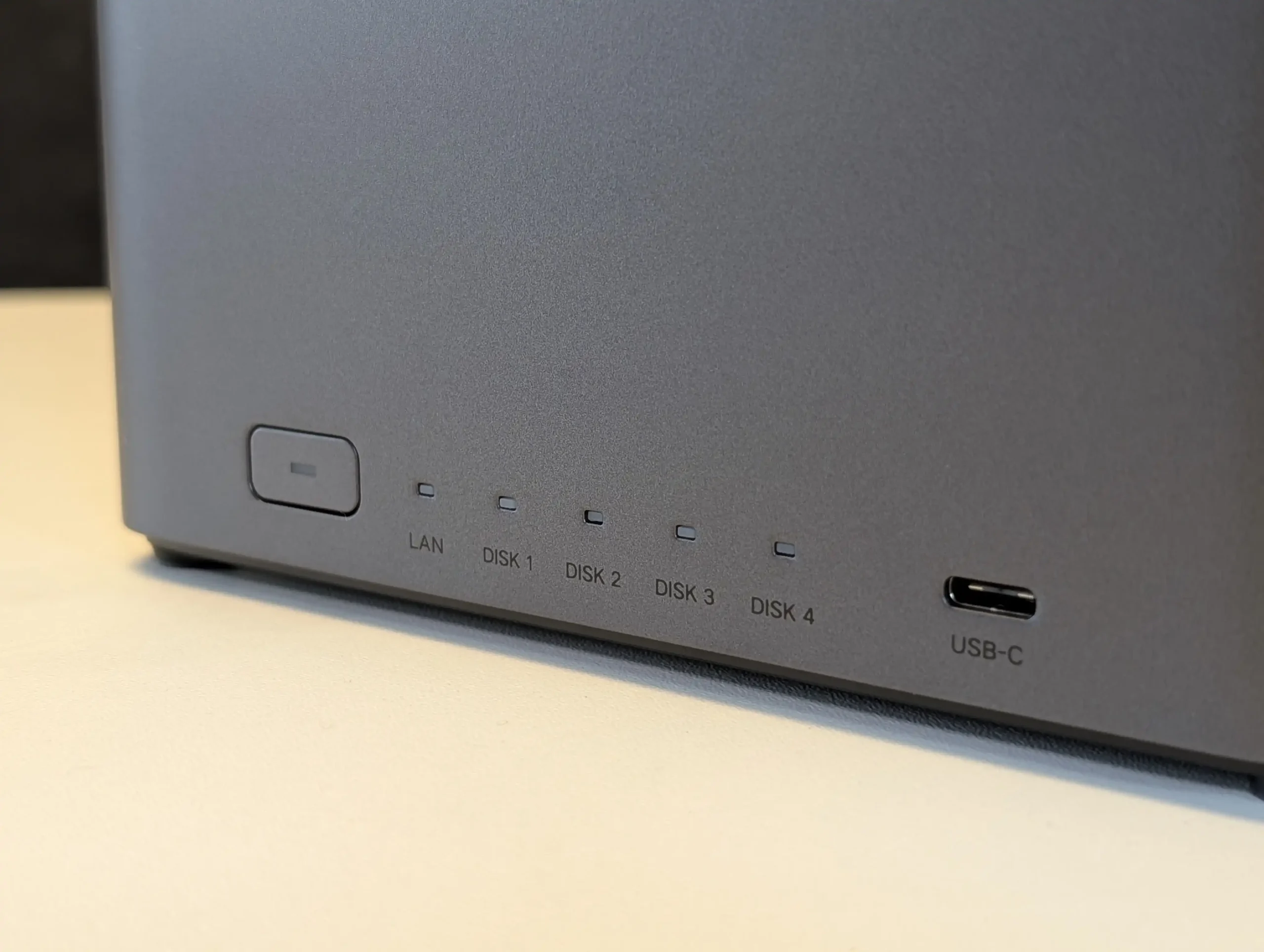
The DH4300 Plus is constructed from a mix of metal and plastic materials, with a soft matte finish and minimal front I/O clutter. This helps the device appear more neutral in office or home setups. All primary status LEDs are located subtly on the front edge, along with a power button and high-speed USB-C port. Despite its budget positioning, UGREEN has maintained an external aesthetic that doesn’t look out of place beside other premium tech. However, internal cost-saving decisions are more evident. The lack of a proper drive locking mechanism or hotswap support reinforces that this NAS is not meant for heavy-duty enterprise usage or high-frequency drive replacement tasks. It is more appropriate as a near-permanent local storage solution once disks have been installed and configured.
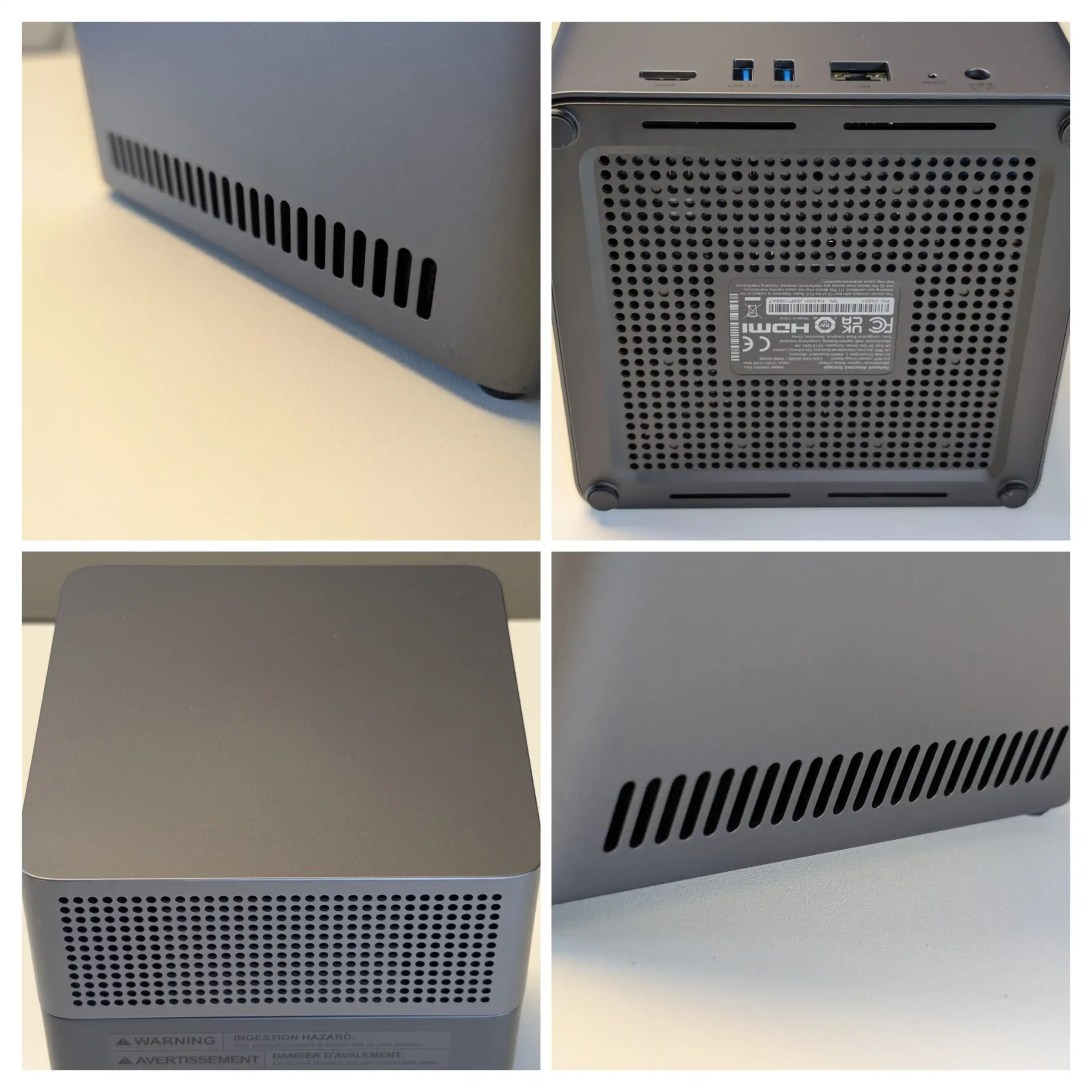
In terms of storage functionality, the DH4300 Plus supports multiple RAID modes, including Basic, JBOD, RAID 0, 1, 5, 6, and 10. This flexibility is notable, as several competing ARM-based NAS units limit RAID options—particularly RAID 6, which requires higher CPU and memory resources to compute parity. While software RAID performance will depend heavily on the chosen configuration and disk types, the Rockchip RK3588 SoC proved capable of maintaining consistent performance in RAID 5 across moderate workloads, including file copying, media playback, and snapshot operations. UGREEN’s system also offers automatic drive recognition and formatting through the UGOS Pro interface, allowing less experienced users to get started quickly, though without the advanced data scrubbing and repair features available on some higher-end NAS platforms.
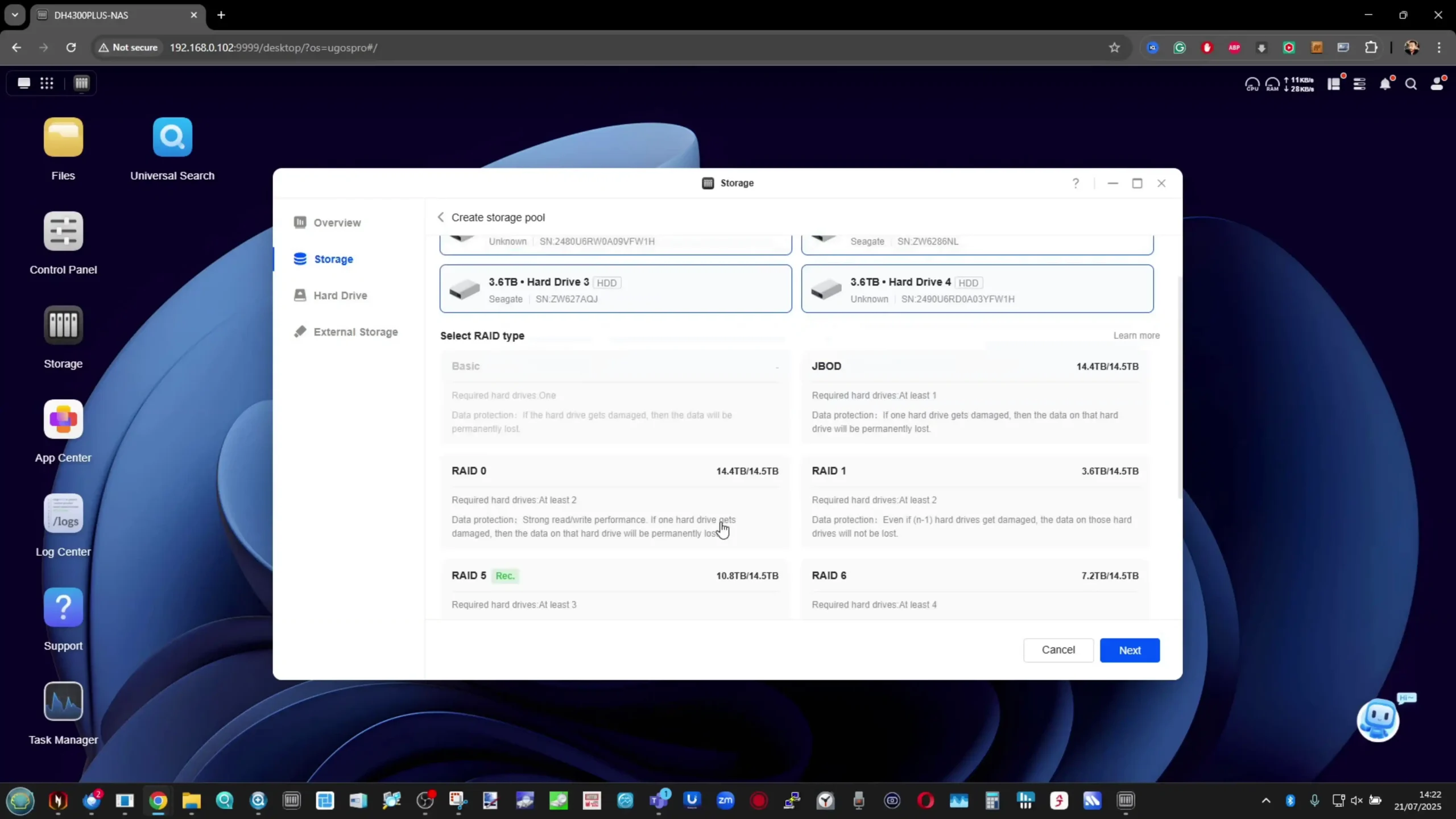
UGREEN DH4300 NAS Review – Internal Hardware
At the heart of the DH4300 Plus lies the Rockchip RK3588 processor, an 8-core ARM-based SoC featuring a hybrid core architecture. It combines four high-performance Cortex-A76 cores with four efficiency-oriented Cortex-A55 cores, providing a significant performance uplift over most ARM-based NAS processors in the same price bracket. The RK3588 includes a Mali-G610 GPU and an integrated NPU capable of delivering up to 6 TOPS of AI performance. This allows for features like facial recognition, object tagging, and scene categorization within UGOS Pro. Notably, this chip has seen growing popularity in DIY NAS and edge computing applications due to its multimedia capabilities and low power draw. Its inclusion in a turnkey NAS platform at this price point positions the DH4300 Plus as an outlier among typical value-series offerings.
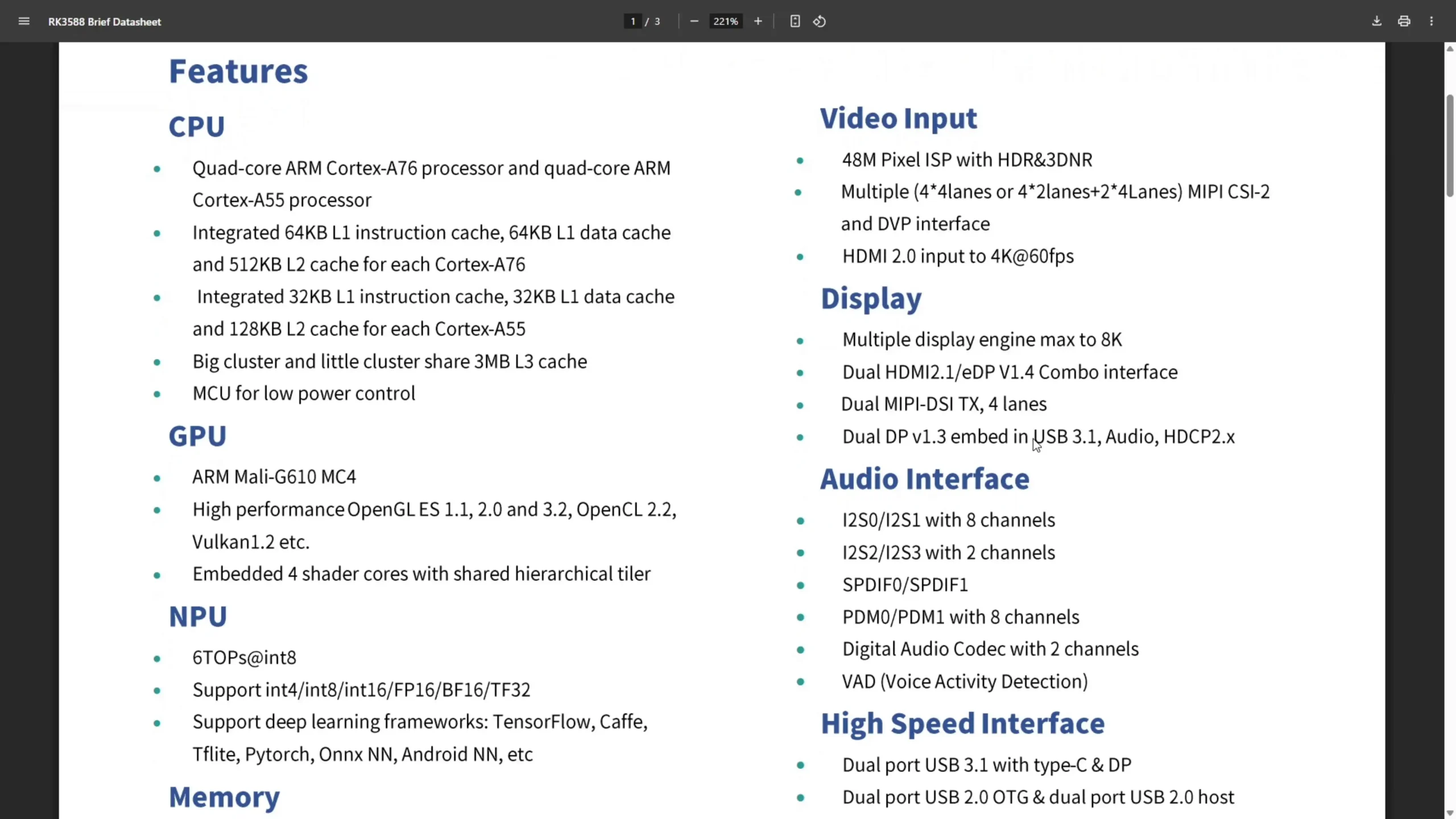
Complementing the processor is 8GB of LPDDR4X memory, which is soldered to the board and not user-upgradable. While this limits long-term scalability, 8GB is a generous amount for an ARM-based NAS and sufficient for most general-purpose NAS workloads including file sharing, media serving, AI-assisted photo sorting, and light Docker container deployment. The system also features a 32GB eMMC module, serving as a dedicated system drive for UGOS Pro. This separation of the OS from user storage pools ensures stability during boot and updates while also freeing up the full capacity of installed SATA drives for data. The lack of NVMe or SATA DOM options means the eMMC is fixed, but in practice, it performed reliably during testing without any bottlenecks.

From a thermal and power standpoint, the RK3588 platform proves to be highly efficient. Even under moderate to heavy loads—such as simultaneous file transfers, streaming tasks, and indexing—the SoC maintains stable temperatures in the low 40s Celsius range. Combined with a modest power draw of around 30–35 watts under active use (and ~4.7 watts at idle without drives), the DH4300 Plus is suitable for continuous 24/7 operation in home or office environments. While the lack of ECC memory or redundant power limits its appeal for enterprise deployment, the core hardware is well-balanced for its target audience, especially when considering how much performance and functionality is packed into a device with a sub-$400 price point.
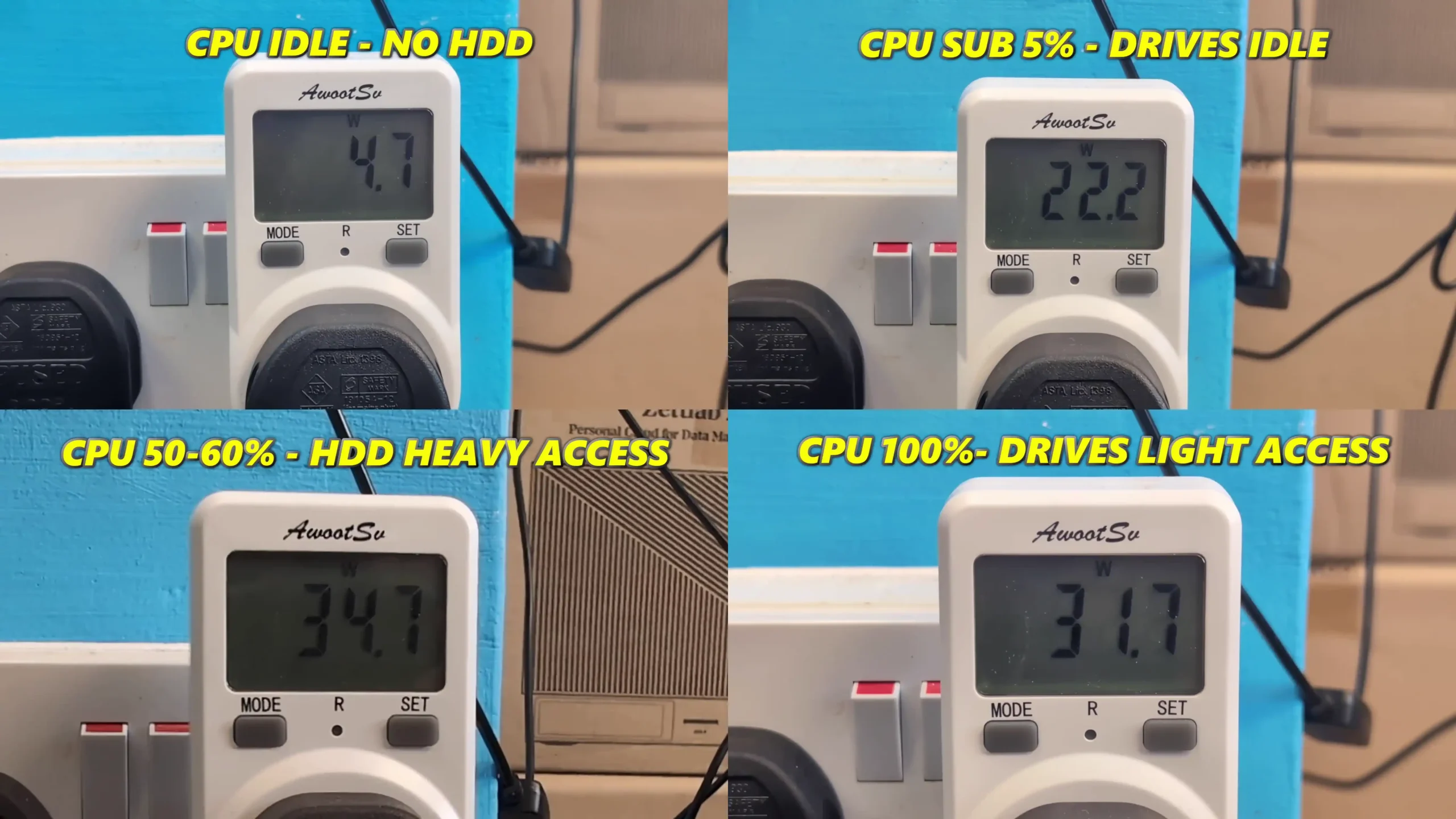
| Component | Specification |
|---|---|
| CPU | Rockchip RK3588 (8-core, up to 2.4GHz) |
| Architecture | 4x Cortex-A76 + 4x Cortex-A55 (64-bit ARM) |
| NPU | 6 TOPS AI acceleration (int4/8/16, FP16, etc.) |
| GPU | ARM Mali-G610 MC4 |
| System Memory | 8GB LPDDR4X (non-upgradable) |
| System Disk | 32GB eMMC (internal OS drive) |
| Drive Bays | 4 x SATA 3.5”/2.5” HDD/SSD |
| Max Storage | Up to 120TB (4 x 30TB) |
| Power Supply | 12V / 6A external adapter |
| Cooling | 1 x internal base-mounted fan |
| Chassis Dimensions | 155 x 155 x 215.7 mm |
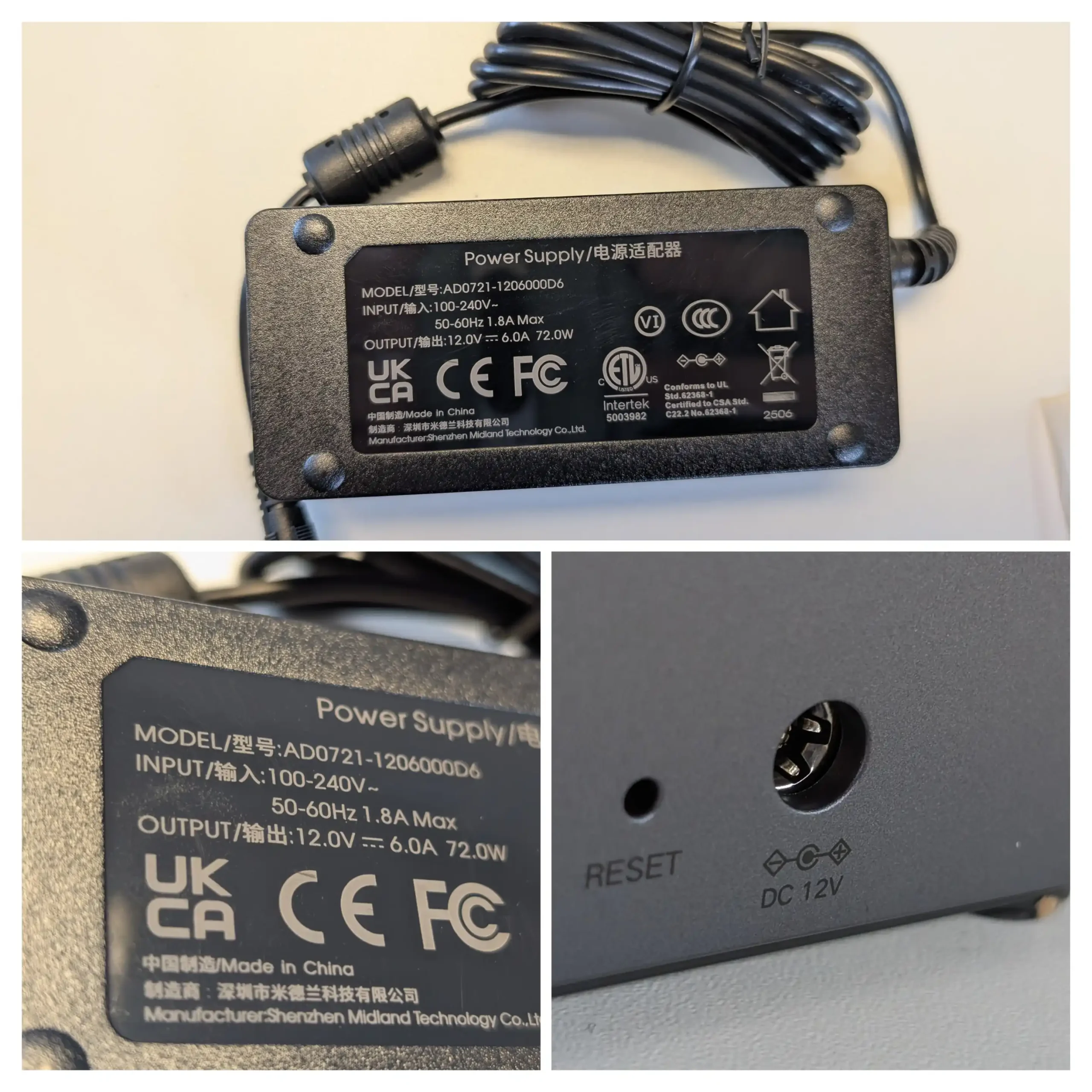
UGREEN DH4300 NAS Review – Ports and Connections
The UGREEN DH4300 Plus offers a streamlined but functionally adequate set of connectivity options for a value-focused NAS. On the front of the device, users will find a USB-C port rated at 5Gbps, accompanied by two additional USB-A ports on the rear capable of 10Gbps transfer speeds. These high-speed USB ports are somewhat unusual on an ARM-based NAS and allow for faster direct-attached storage backups or peripheral integration, including UPS management or external media access. While not hot-swappable in the OS UI, the ports performed reliably in tests when mounting USB SSDs and thumb drives for quick file transfer and offline sync. Their positioning also maintains a tidy cable layout, with most high-traffic connections located on the back panel.
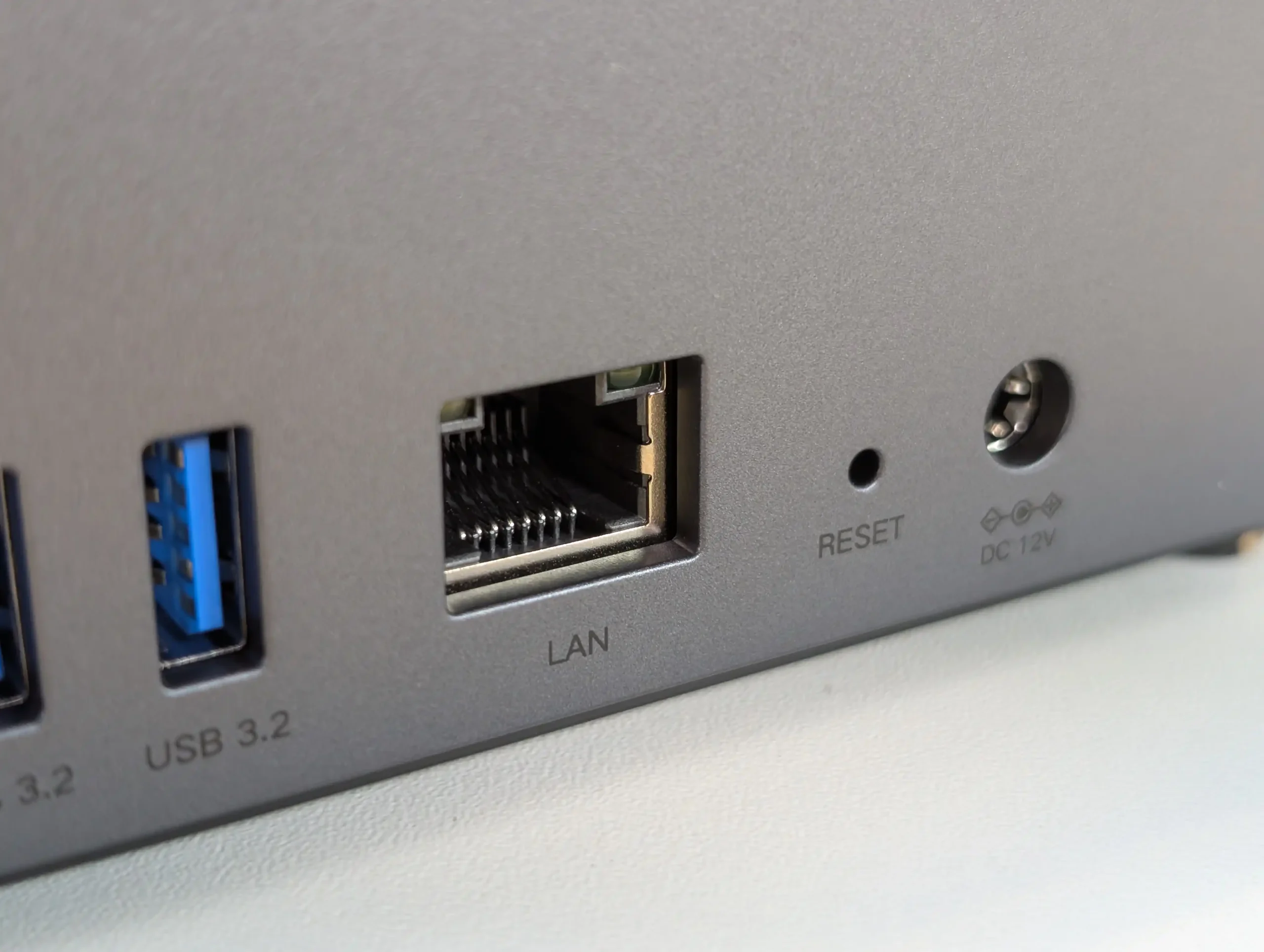
Network connectivity is delivered through a single 2.5GbE RJ45 port, which represents a solid step above the standard 1GbE ports found on most entry-level NAS units. This allows the DH4300 Plus to exceed typical Gigabit transfer speeds, reaching up to ~280MB/s in peak file transfer tests using large sequential data. However, the inclusion of only one LAN port means there’s no support for link aggregation or failover. This limits the device’s flexibility in multi-user environments or scenarios requiring redundancy. Given the hardware capabilities of the RK3588 platform, a second LAN port—or even a fallback 1GbE—would have been ideal. Still, for a single-user or small team deployment, the 2.5GbE connection is more than sufficient for everyday access to large media files, backups, and collaborative workspaces.
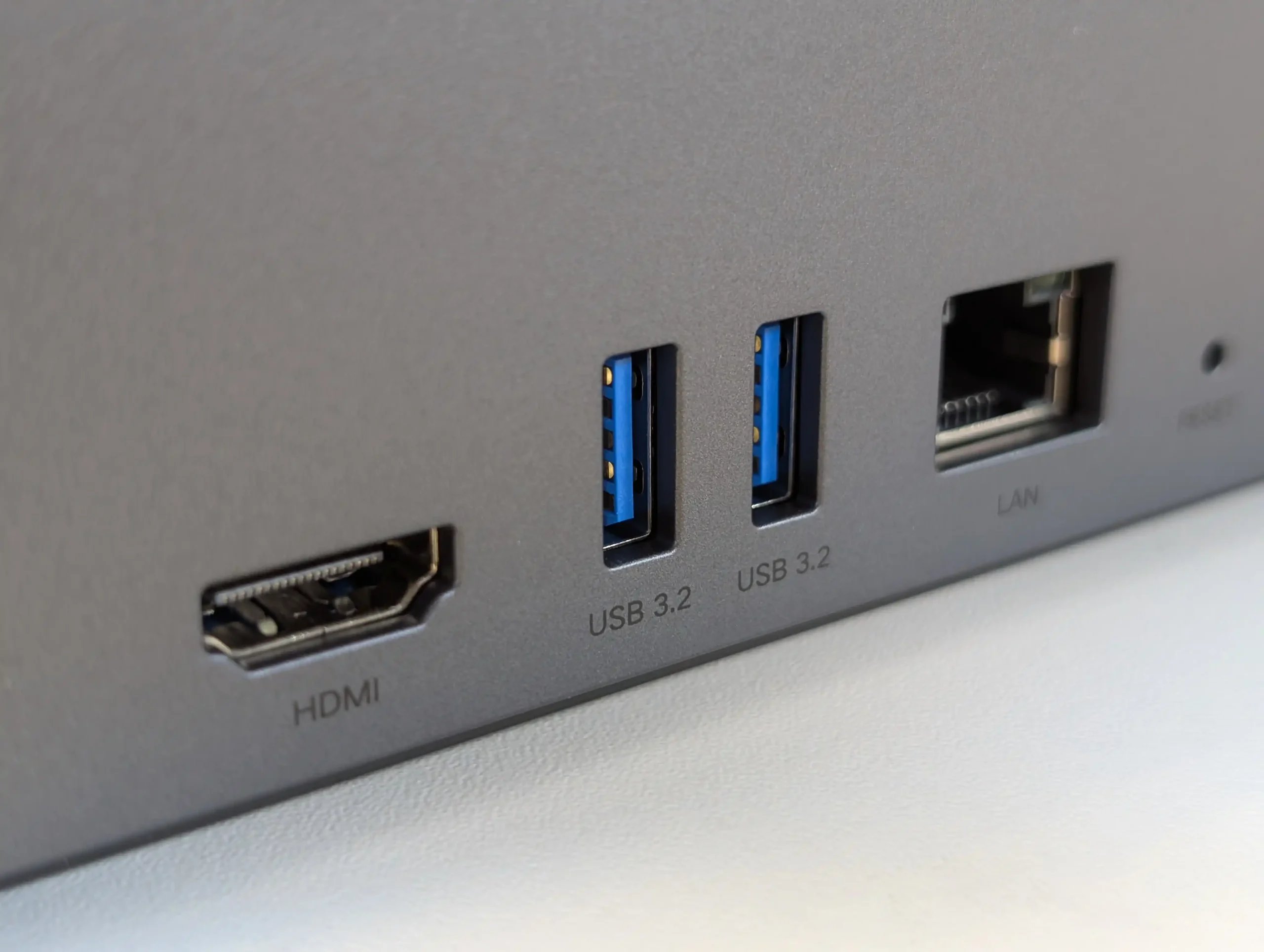
One of the most unexpected and welcome features is the presence of an HDMI 2.1 output, capable of 4K at 60Hz. HDMI on value-tier NAS systems is uncommon, and its inclusion here enables media playback, real-time NAS control via a directly connected monitor, and potential kiosk or signage applications. The UGOS Pro operating system includes a built-in theater mode to pair with this feature, although its capabilities are more basic than those found in platforms like QNAP’s HD Station. Nevertheless, for users wanting to leverage the NAS as a lightweight local media center or for on-site admin access without relying solely on browser-based control, the HDMI output adds flexibility. The only caveat is that the device lacks any form of PCIe expansion, so users cannot add additional ports or NVMe caching options later.
| Port Type | Specification |
|---|---|
| LAN | 1 x 2.5GbE RJ45 |
| USB-C (Front) | 1 x USB 3.2 Gen 1 (5Gbps) |
| USB-A (Rear) | 2 x USB 3.2 Gen 2 (10Gbps) |
| HDMI Output | 1 x HDMI 2.1 (4K 60Hz) |
| PCIe Expansion | None |
| Drive Interface | 4 x SATA III (direct backplane) |
| Power Input | 12V / 6A DC barrel connector |
And for those concerned about noise, the system was surprisingly low noise, for it’s scale. It will, of course,e depend on the kind of drives you use (anything above around 12TB in a 4 disk configuration will likely be louder than the system fans, regardless), but the UGOS NAS software also has some level of fan control (low/high) too which can be adjusted if needed. Overall, the noise level was pretty good for a 4 disk NAS.
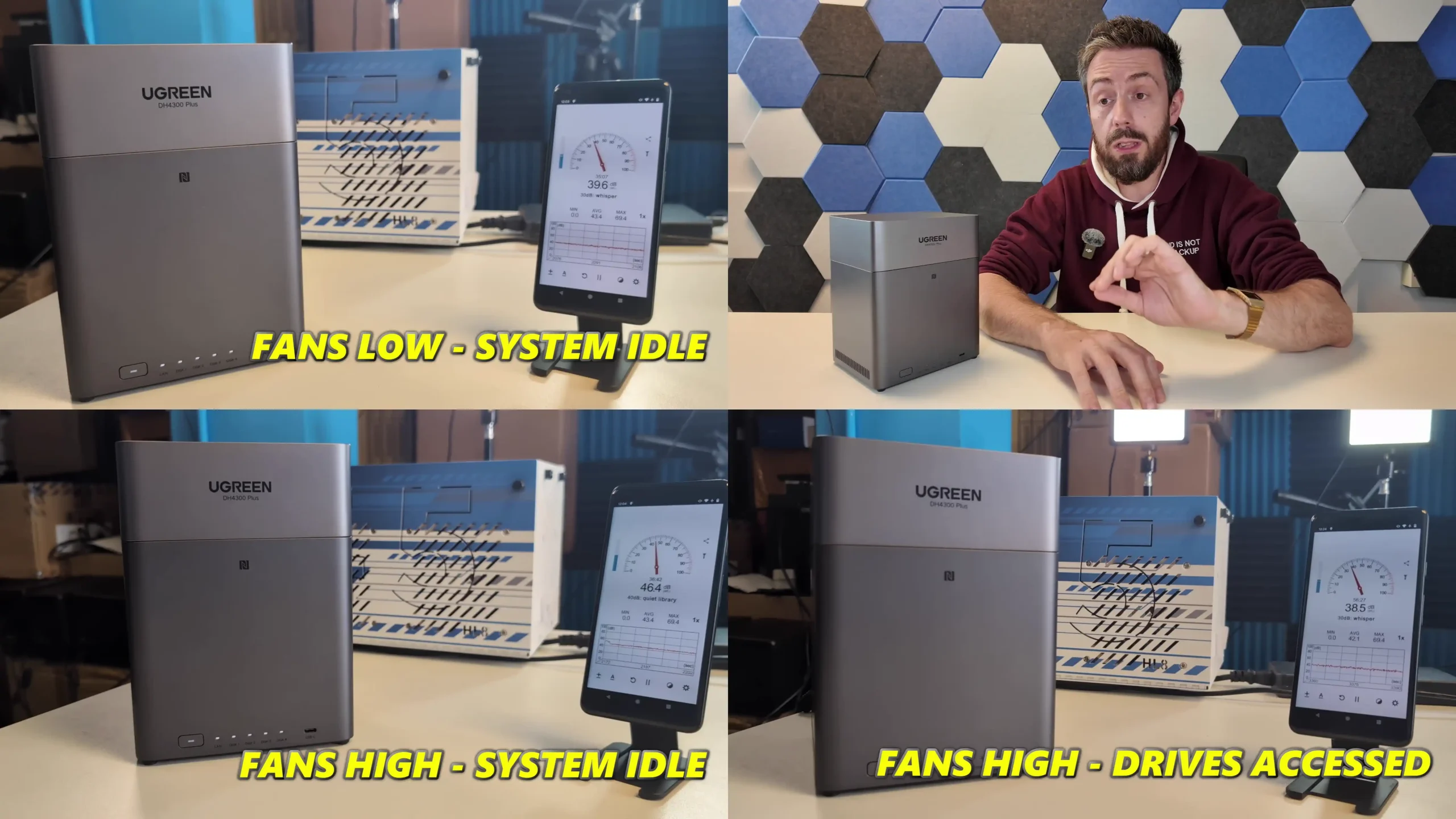
UGREEN DH4300 NAS Review – Software and Services
The DH4300 Plus runs UGOS Pro, UGREEN’s proprietary NAS operating system tailored for ARM-based platforms. While it doesn’t match the feature depth of more mature systems like Synology DSM or QNAP QTS, UGOS Pro has seen steady improvements and now covers most of the foundational functions expected from a modern NAS. The UI is browser-accessible and includes modules for storage management, user permissions, cloud sync, backups, and multimedia playback. During testing, the OS handled basic setup, RAID initialization, and file system formatting efficiently. Users can configure shared folders, enable SMB/NFS/AFP protocols, and even set up multi-tiered backup routines to local, USB, or cloud destinations such as Google Drive and Dropbox.
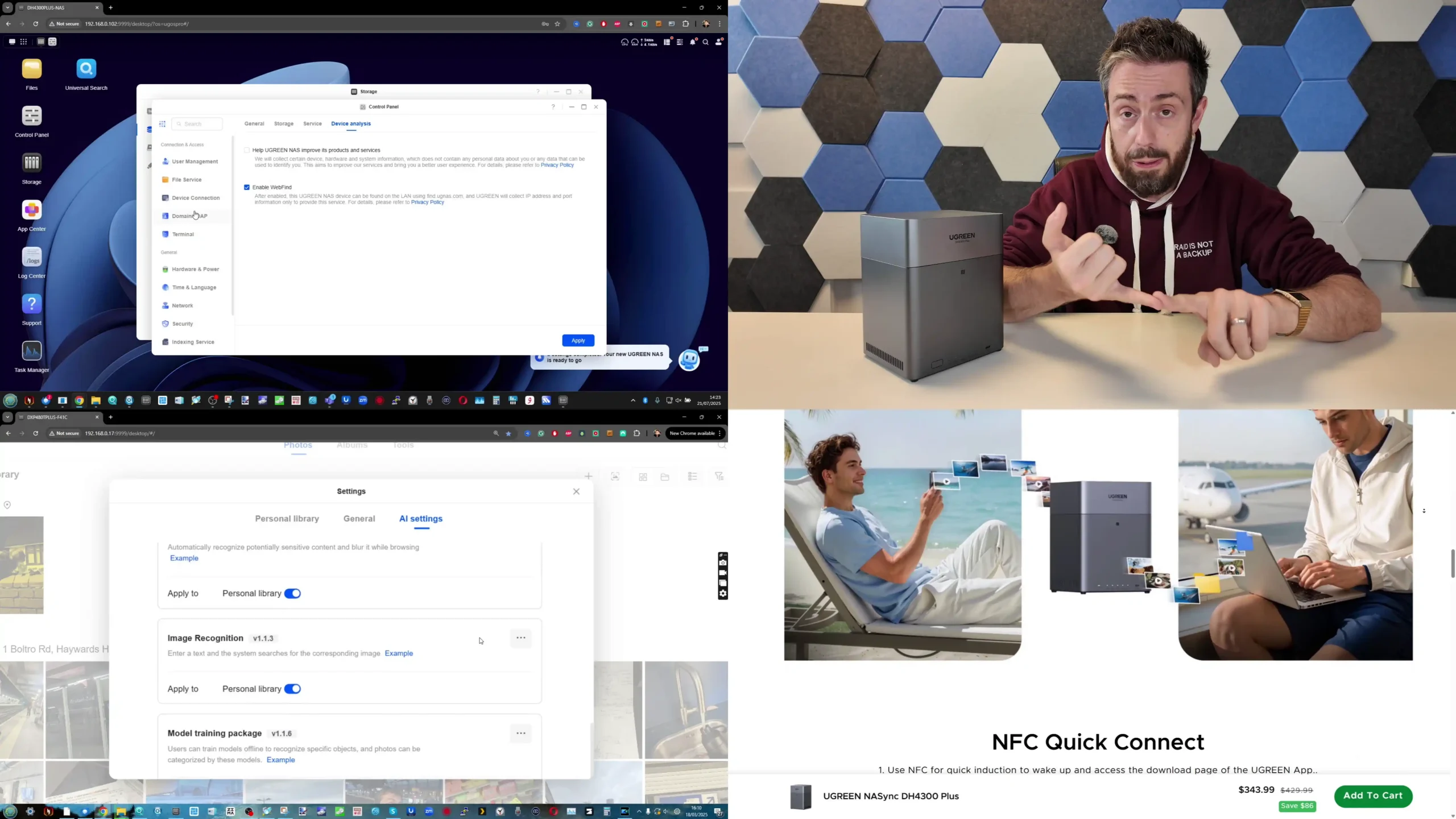
One of the more advanced features is the integrated AI photo engine, which leverages the RK3588’s NPU to organize media libraries using facial recognition, object tagging, and scene classification. This is similar in principle to what Synology Photos or QNAP QuMagie offer, though UGOS Pro lacks the same level of customization or filtering depth. The system can automatically generate albums, identify duplicates, and even create baby-focused timelines.
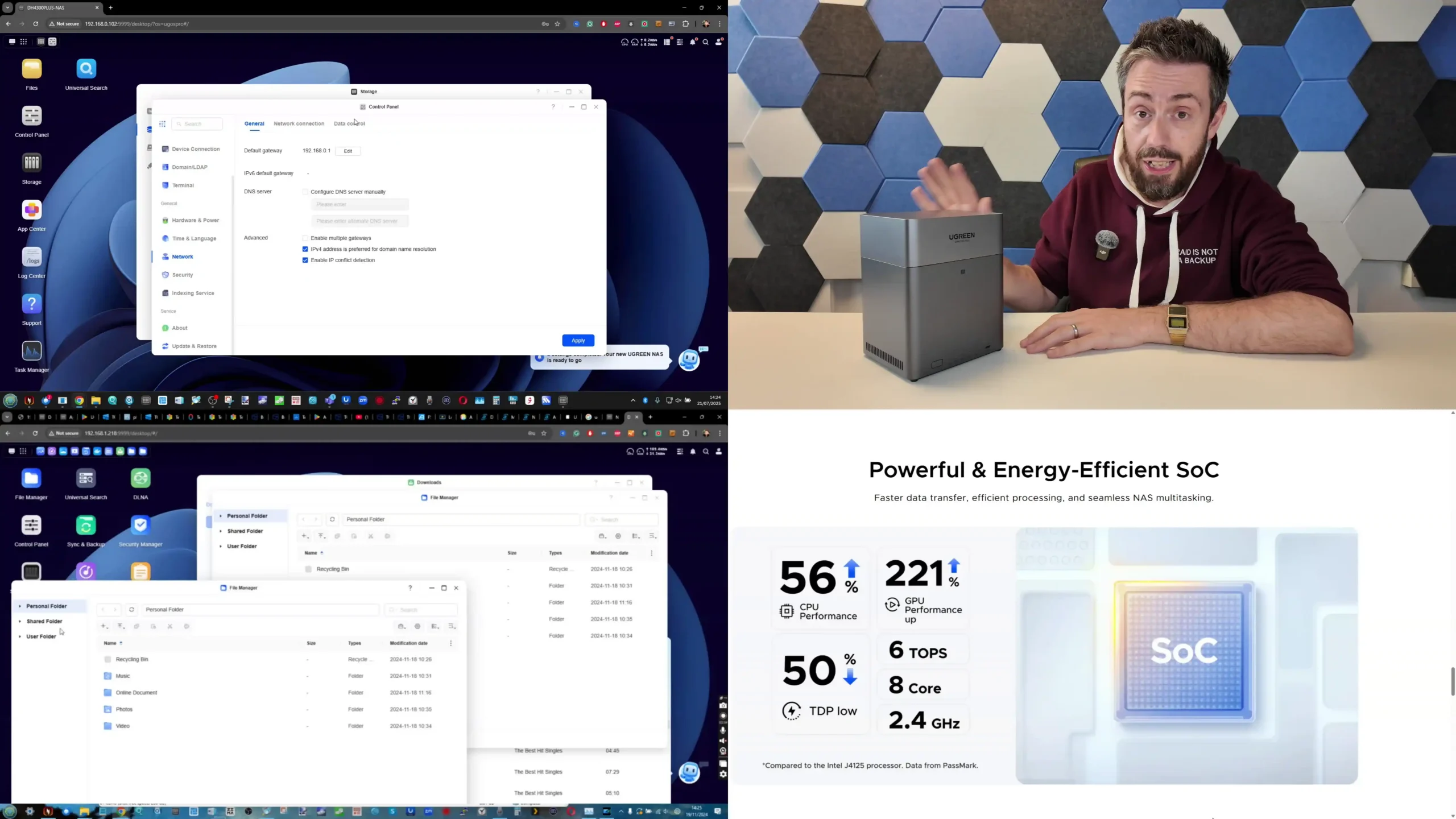
These features worked reliably on smaller photo sets but began to slow down when indexing larger libraries—likely a result of both memory and algorithmic efficiency. Despite this, the inclusion of AI functionality in a sub-$400 NAS is notable, especially since it runs locally and does not require cloud processing.
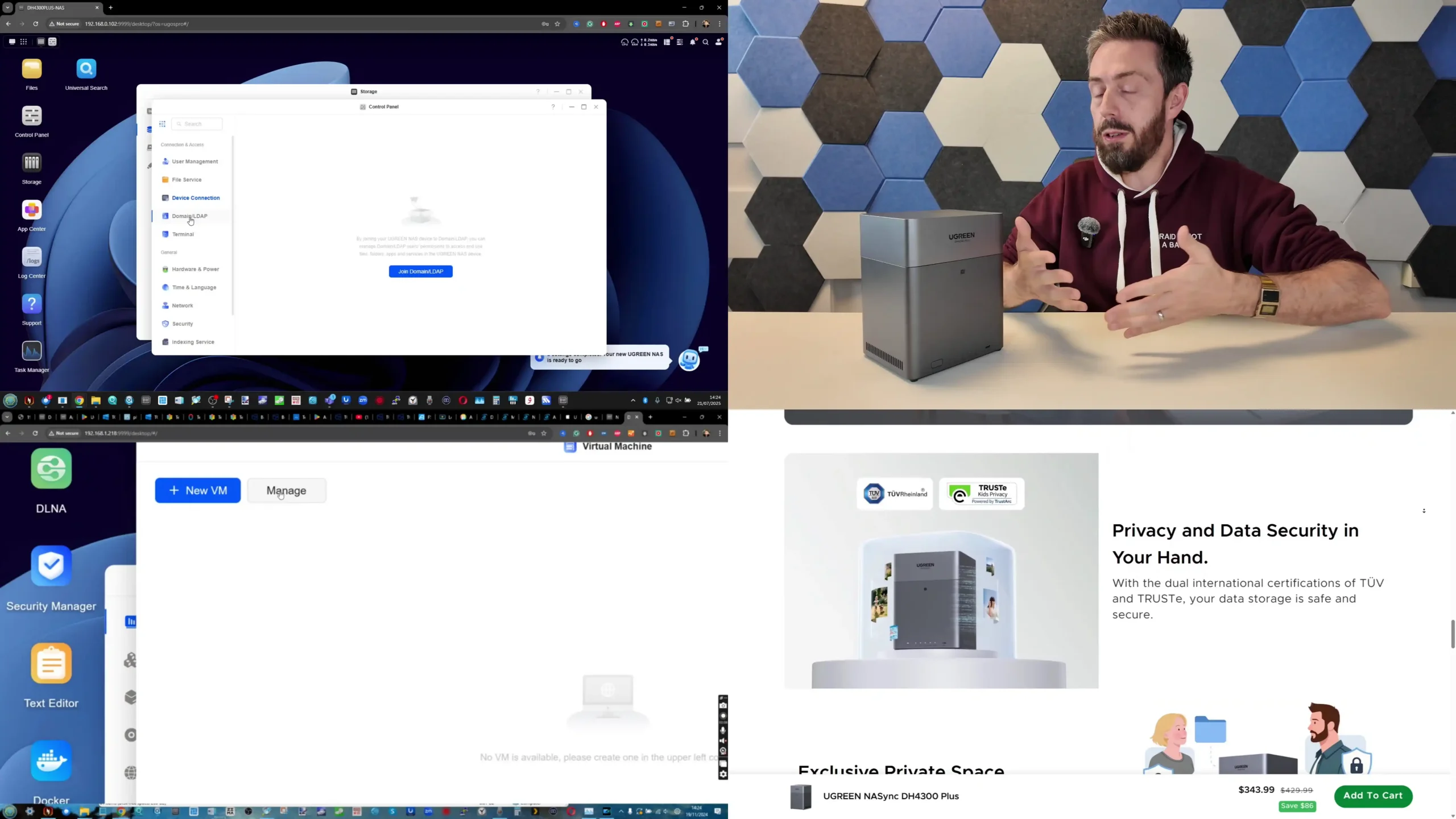
Application support is growing within UGOS Pro. Native apps for file access, media playback, surveillance (limited), and mobile sync are included, along with support for Docker containers, allowing users to sideload additional tools not officially available. Notably, BTRFS is supported as a file system option, enabling snapshot functionality and some degree of data integrity checks. However, there are limitations: virtualization is not supported due to the ARM architecture, and there’s currently no iSCSI target support.
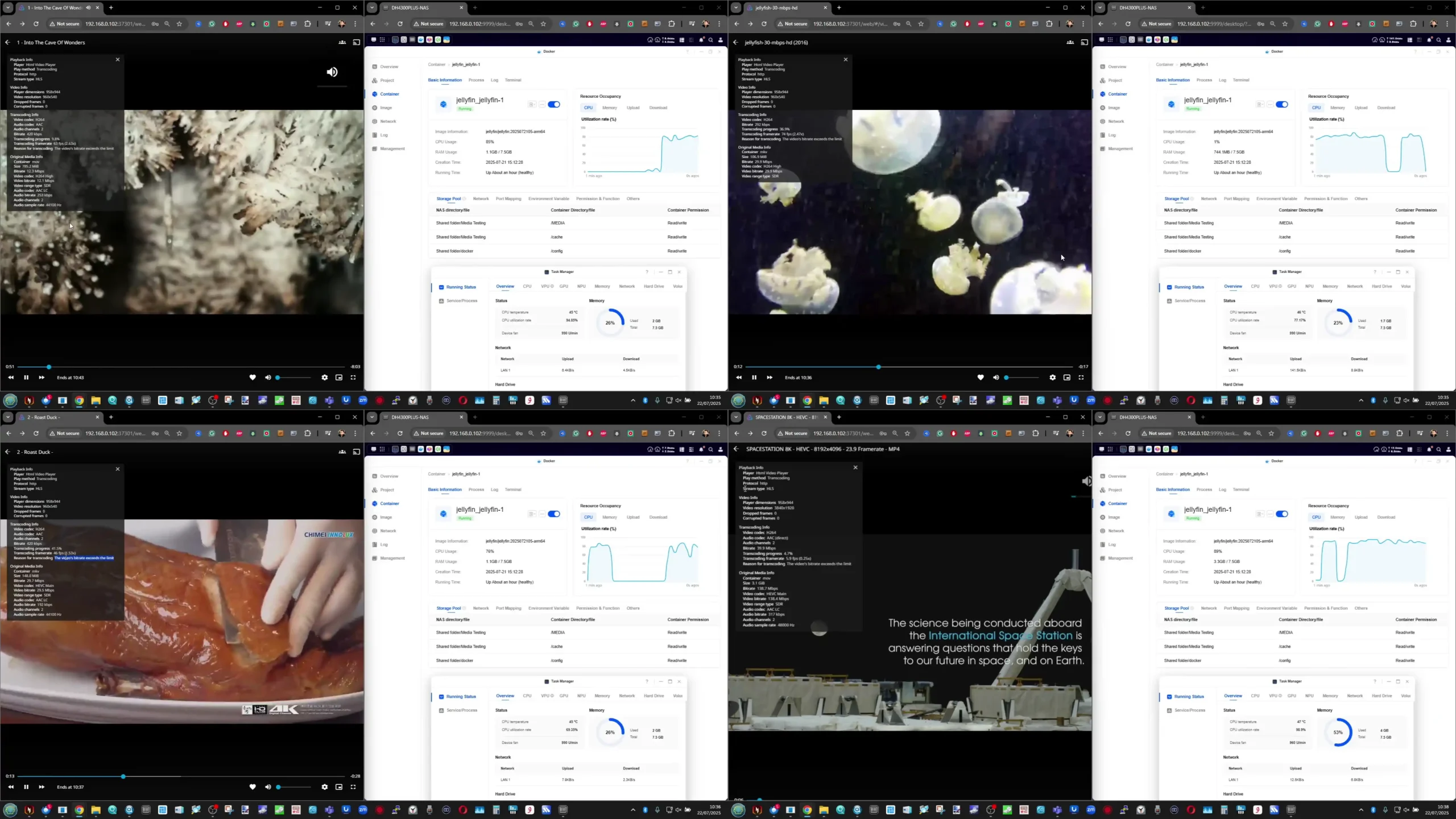
Additionally, while the broader UGREEN ecosystem includes a Jellyfin app for other devices, this model did not have native Jellyfin support at launch—requiring users to deploy it manually via Docker. Features like multi-factor authentication, scheduled shutdown/start, and remote access are included, but power users may find the interface lacking compared to more polished systems.
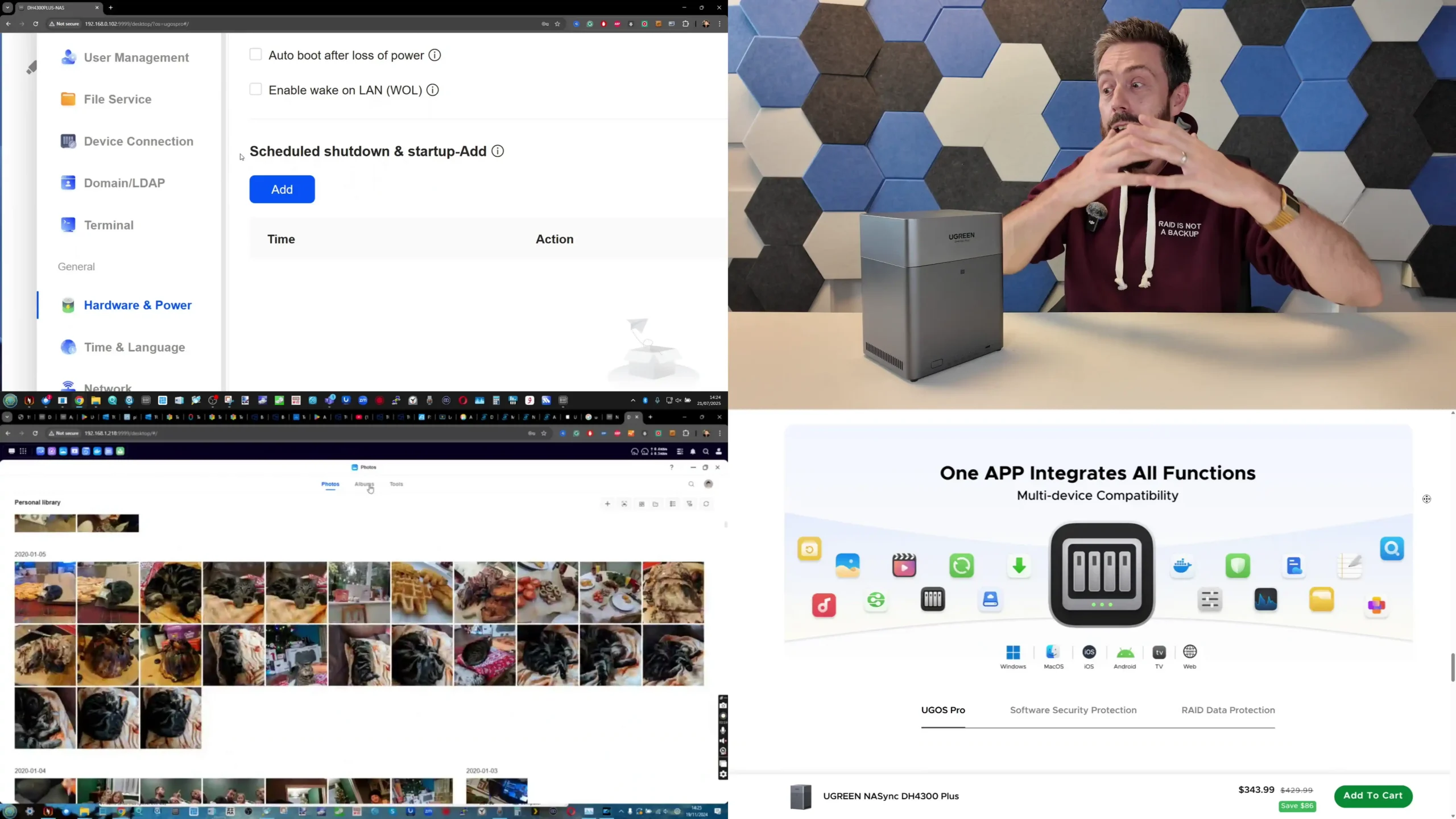
UGREEN DH4300 NAS Review – Verdict and Conclusion
The UGREEN DH4300 Plus carves out a unique niche in the budget NAS landscape by delivering hardware typically reserved for higher-tier systems at a much lower price point. Its RK3588 processor, 8GB of RAM, and support for 2.5GbE networking place it well ahead of most similarly priced competitors in terms of raw specifications. Additionally, features such as HDMI output, 10Gbps USB ports, and local AI-powered photo indexing are rare to find in entry-level NAS systems. Despite its plastic-heavy internal design and lack of expansion options like PCIe or M.2, the device delivers stable performance for file sharing, media access, and low-intensity AI workloads. It is not suited for power users demanding virtual machines or advanced snapshot automation, but within its class, the DH4300 Plus presents an appealing balance between cost and capability.
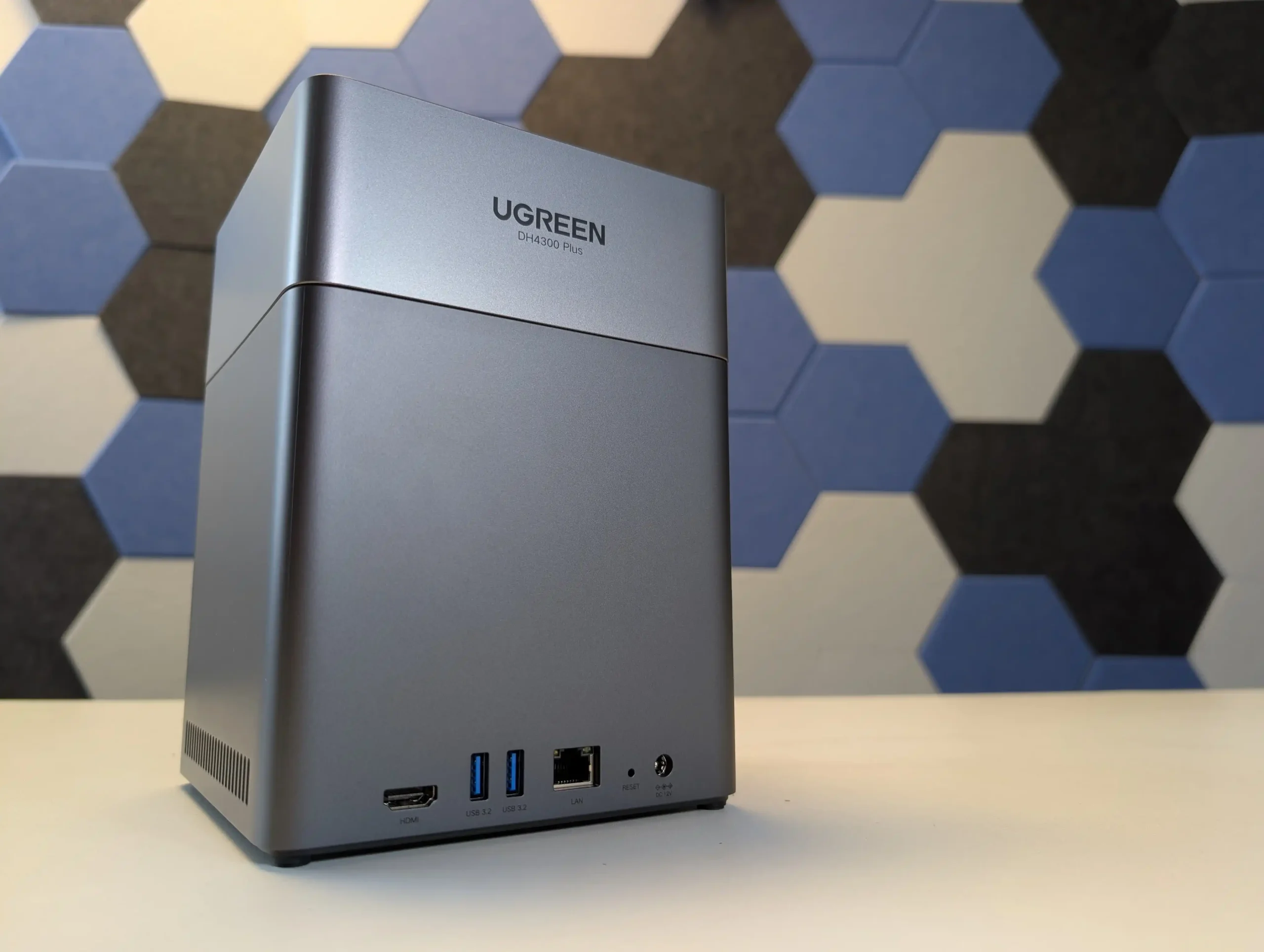
That said, the software experience is still a work in progress. UGOS Pro covers the essentials and offers a visually accessible UI, but lacks the advanced features and ecosystem integration found in more mature platforms like Synology DSM or QNAP QTS. Docker and snapshot support add welcome flexibility, but the absence of native Jellyfin, iSCSI, and VM functionality limits its use in more complex environments. Still, for home users, media collectors, or small office setups looking for reliable backup, modest AI-enhanced photo sorting, and smooth 4K playback, the DH4300 Plus delivers value well beyond its price tag. While it won’t replace high-end NAS appliances, it serves as a capable, efficient, and quietly innovative option in a saturated entry-level NAS market.
| Buy the UGREEN DH4300 on Amazon @409 | Buy the UGREEN DH4300 on UGREEN.COM | Buy the UGREEN DH4300 on B&H |
 |

|
 |
| PROs of the UGREEN DH4300 NAS | CONs of the UGREEN DH4300 NAS |
|
|
📧 SUBSCRIBE TO OUR NEWSLETTER 🔔
🔒 Join Inner Circle
Get an alert every time something gets added to this specific article!
This description contains links to Amazon. These links will take you to some of the products mentioned in today's content. As an Amazon Associate, I earn from qualifying purchases. Visit the NASCompares Deal Finder to find the best place to buy this device in your region, based on Service, Support and Reputation - Just Search for your NAS Drive in the Box Below
Need Advice on Data Storage from an Expert?
Finally, for free advice about your setup, just leave a message in the comments below here at NASCompares.com and we will get back to you. Need Help?
Where possible (and where appropriate) please provide as much information about your requirements, as then I can arrange the best answer and solution to your needs. Do not worry about your e-mail address being required, it will NOT be used in a mailing list and will NOT be used in any way other than to respond to your enquiry.
Need Help?
Where possible (and where appropriate) please provide as much information about your requirements, as then I can arrange the best answer and solution to your needs. Do not worry about your e-mail address being required, it will NOT be used in a mailing list and will NOT be used in any way other than to respond to your enquiry.

|
 |
Gl.iNet Flint 4 10G+2.5G Router Revealed @CES 2026
EVERYTHING NEW from Minisforum @ CES 2026
Gl.iNet Slate 7 PRO Travel Router (and Beryl 7) REVEALED
Minisforum N5 MAX NAS - 16C/32T, 128GB 8000MT RAM, 5xSATA, 5x M.2, 2x10GbE and MORE
The BEST NAS of 2026.... ALREADY??? (UnifyDrive UP6)
How Much RAM Do You Need in Your NAS?
Access content via Patreon or KO-FI
Discover more from NAS Compares
Subscribe to get the latest posts sent to your email.


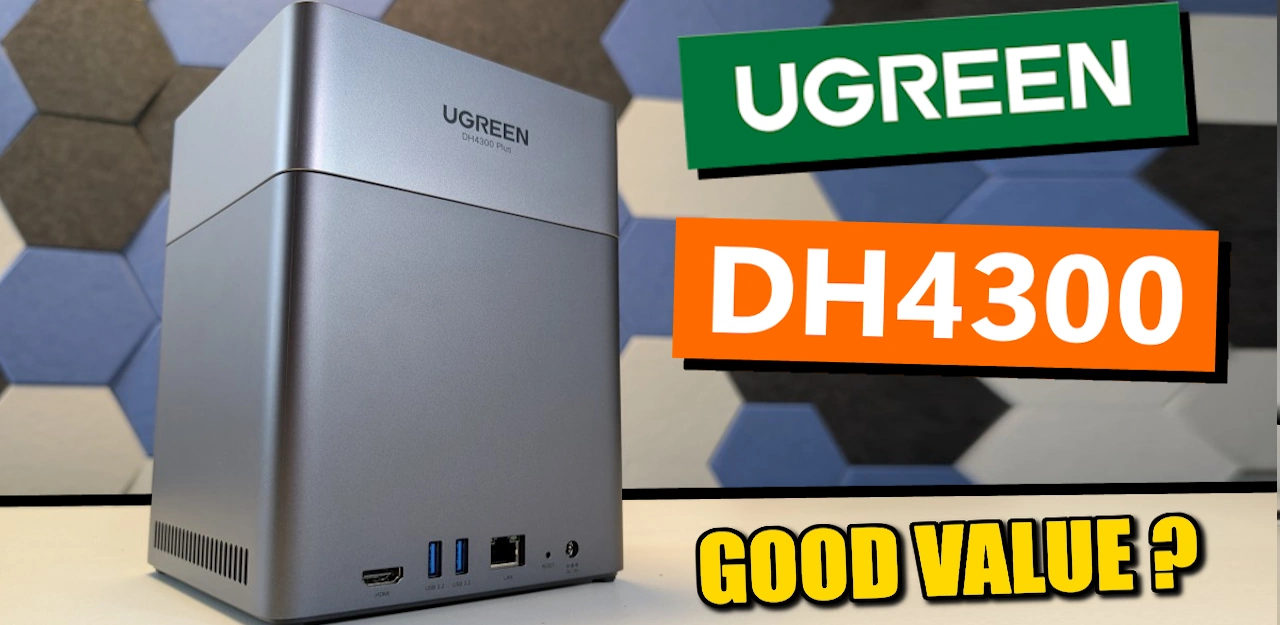
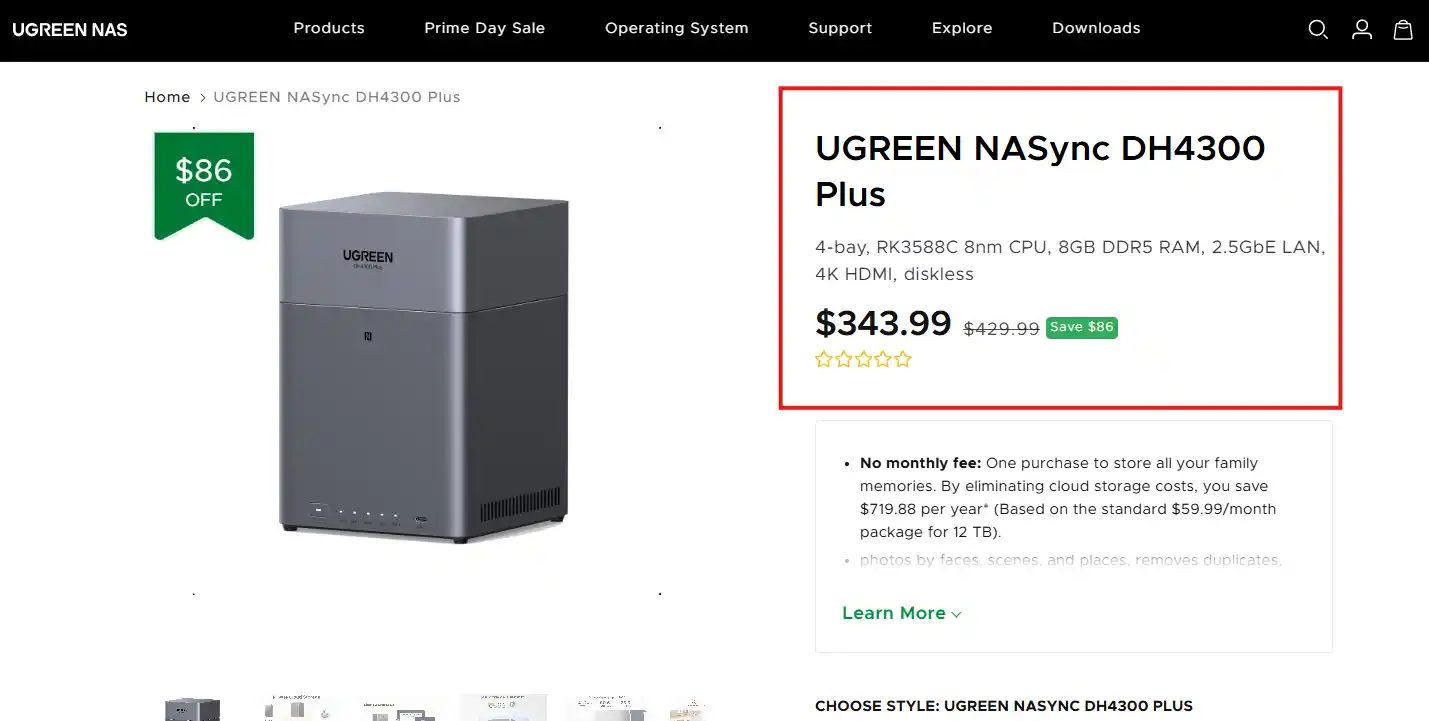
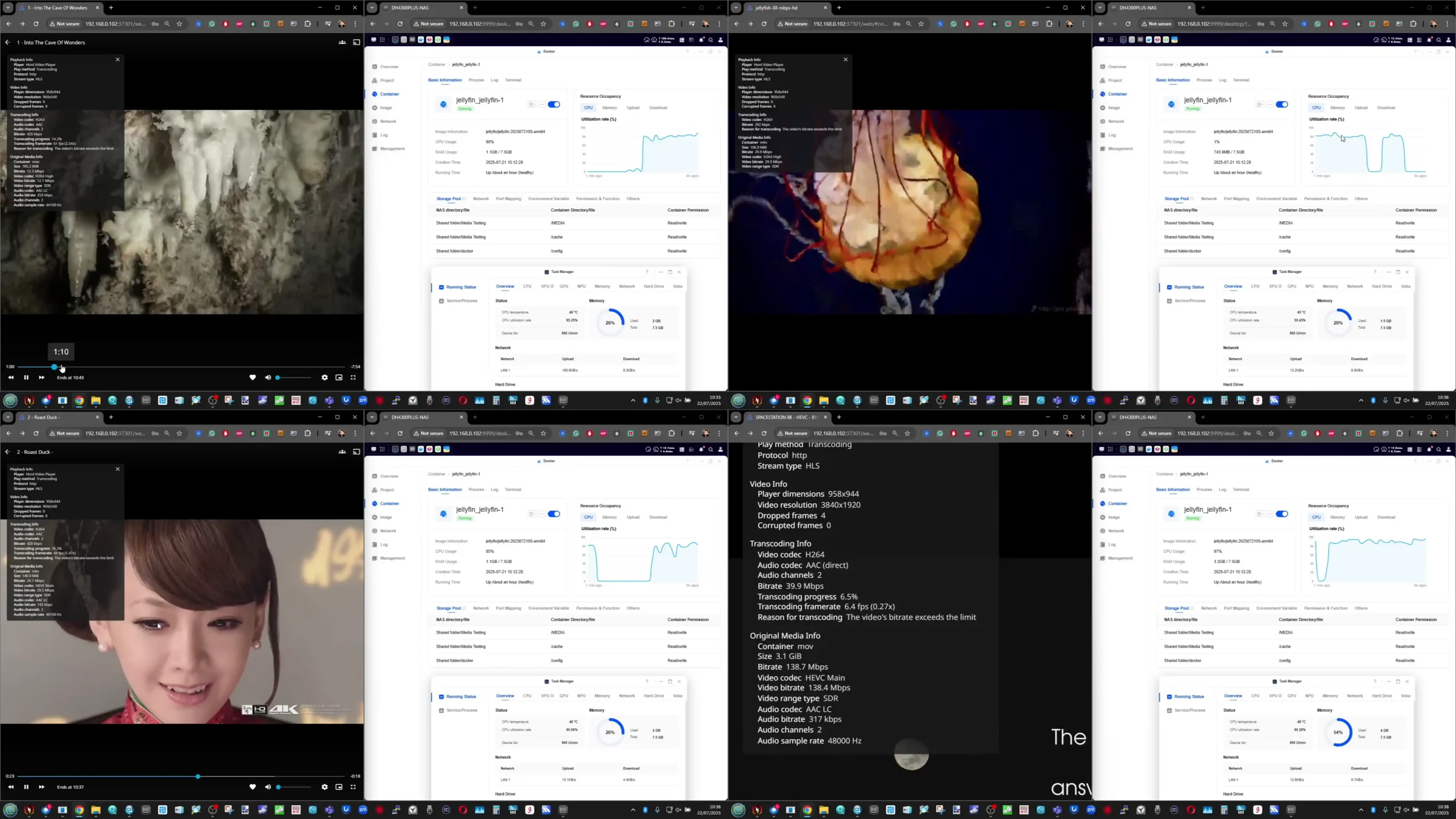
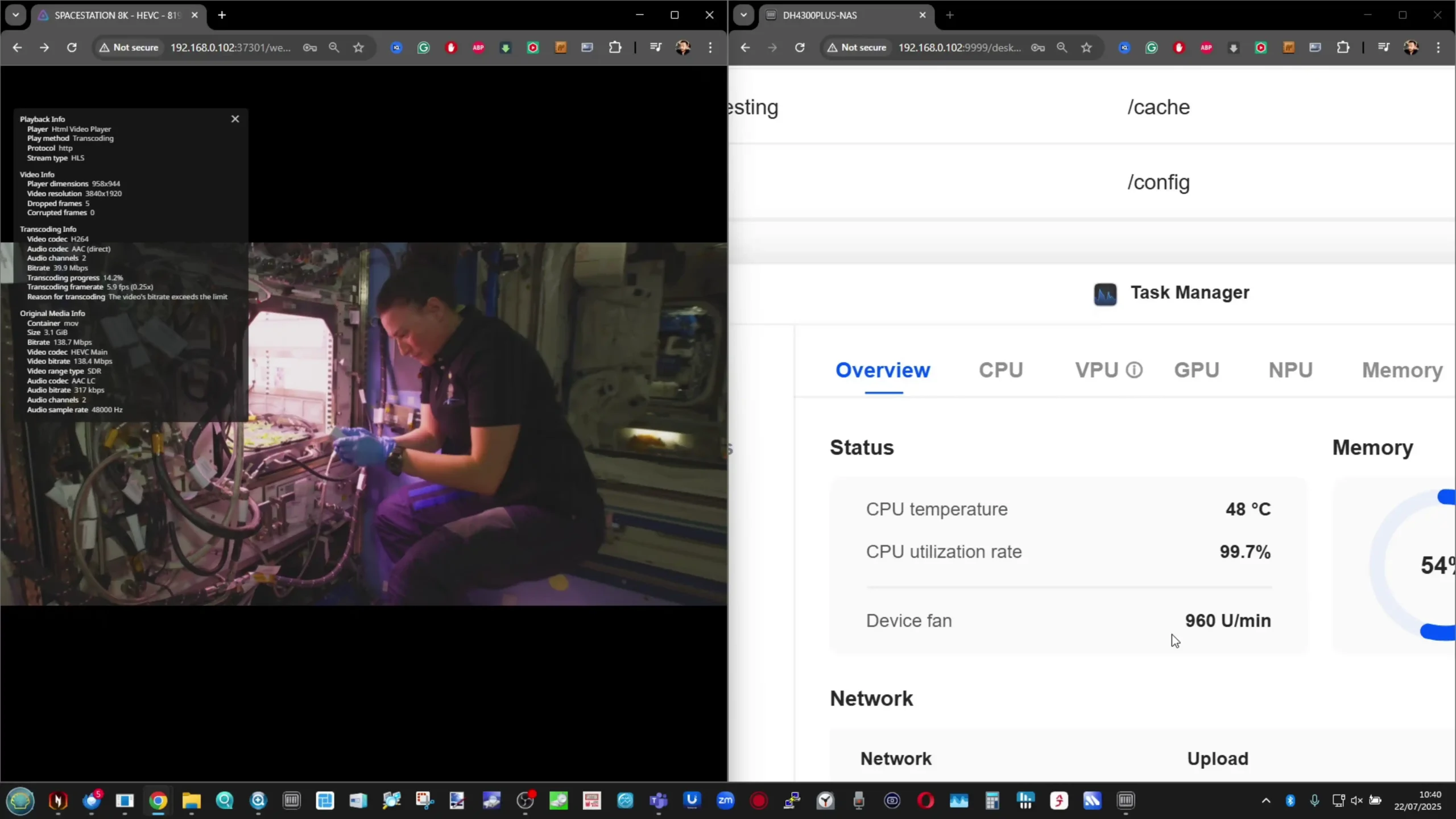



one NIC is a weakness
REPLY ON YOUTUBE
1:18 Lol. Omg. The three-fidy reference was bananas. I’m just sad you didn’t replay it the second time.
REPLY ON YOUTUBE
great
REPLY ON YOUTUBE
I wonder how this unit stacks up against a similar TERRAMASTER F4-425 Enclosure? Would be great to see them compared since they serve basic user needs. I would lean towards the Terramaster F4-425 with an Intel Quad-Core for about $379 which is about the same price. Have fairly large Movie and TV Series set of files, most all 1080p up to 4K for some movies. Seems like an interesting choice.
REPLY ON YOUTUBE
I’m not sure tbh, when I think of “Ugreen” I think of cheap cables on Amazon that got lucky and are now mass producing other stuff. I currently have a 7-8 year old QNAP NAS that is still getting regular firmware and security updates to this day, I have zero confidence in a company like Ugreen offering anything close to that. It wouldn’t surprise me if they just abandoned each product after launch whilst moving onto the next one. I might be wrong but I haven’t seen anything yet to counter that
REPLY ON YOUTUBE
Hmmm… As far as I can see there is only RAID 5, and there is nothing like the Terramaster TRAID or Synology SHR. That gives a limit on mixing drive sizes. I can be wrong here of course, but in my case (having several sizes of disks) it would be not very cost-effective.
REPLY ON YOUTUBE
what storage hhd/sdd would you guys recommend? even though it is a 4 bay can you start with a 2 bay?
REPLY ON YOUTUBE
Question, could I just build a mini pc with m.2 and hard drives. Only thing is where can I get that software where it’s app compatible with Apple? with phone seamless transfers ect??
REPLY ON YOUTUBE
Partly because of your review, I purchased a DH4300Plus. I could never get the transmission speed above. Different cables different computers, different software to transfer files, help from Gemini, nothing helped. 4T drives virtually new. Ugreen support in spite of the network lights and screen shots/the log immediately blamed my Decox55 router, and using EaseUS To Do. Using different suggestions from Gemini left little doubt that is the box. Sadly, with Ugreen’s customer service this is going back.
REPLY ON YOUTUBE
I wonder if the DH4300 is enough if two or three watch Video in Hd. Is that Possible, or is it to much for that? I struggle to decide if i buy 4800 or 4800plus or the 4300plus…. i want to Stream Video/Music an and outside of the Home for the Family. Hmm…. any ideas?
REPLY ON YOUTUBE
like your reviews, but i don´t like the quad display format where u put 4 screens up at the same time , you can´t see anything, more confussing than usefull… !
REPLY ON YOUTUBE
don’t use the cloud..store your personal information and data on a chinese box…sure that safe
REPLY ON YOUTUBE
Does this come with the 4 drives or do we have to purchase them separately?
REPLY ON YOUTUBE
Thoughts on this vs the UNAS 4?
REPLY ON YOUTUBE
Ugreen is one of those companies like anker that just appeared one day and stuck around because they just did stuff better
REPLY ON YOUTUBE
Wait. Someone plz correct me asap before I purchase an inferior model. I could’ve sworn the ugreen website stated the dh4300 contained the same 128gb ssd flash memory like the dxp4800+. This video showed a snapshot of the dh4300 having a lesser grade 32gb emmc. Which is it?
REPLY ON YOUTUBE
Great video.how check if this device genius or fack!?
REPLY ON YOUTUBE
Now this has cought my attention, i have a dxp4800plus and am about to change out hdd for mor capacity which will leave me with the 4 hdd, im now considering this just to throw them hdd in, id be interested to see the performance difference for cloud storage and plex and jelyfin etc side my side, on the face of it seems like quite an exiting product
REPLY ON YOUTUBE
Can we remove the boot drive and install TrueNas on it like other Ugreen units?
REPLY ON YOUTUBE
can you use SATA 2.5 SSD instead of big bulky HDD ?
REPLY ON YOUTUBE
I am loving EVERYTHING UGreen! From Cables, Hubs, CHargers and Power Supplies I also invested in a SATA HDD Unit and now thinking about adding this baby to my current NAS setup of Synology DS220+ and QNAP TS-x31P3 🙂 Great overview, helpful, detailed and I will use the link to order!
REPLY ON YOUTUBE
A real noob questions, can it download from OneDrive directly? When it is inn same Wifi network, is it faster than OneDrive to get my files?
I use OneDrive for photo storage and after I imported my files to my Mac, I upload them to OneDrive and download them if needed. But OneDrive’s storage is approaching its limit and it is too slow to download files on my Mac when I need them, I need a storage that I can use instead of OneDrive .
Thanks in advance for all help
REPLY ON YOUTUBE
Why so different in temps? My synology let my drives (16tb ironwolfs pro) 30-34c max and here 45? The same was in dxp4800, I thought it was because of different drives I used in -non pro 8tb ironwolf but it seems it’s not the case
REPLY ON YOUTUBE
So… to use it mainly as a plex server (4k only) should I go with this or the dxp2800? Does this follow the price ladder in Capability (minus the bays) of dxp2800
Does it auto power on? Also, do SATA ports support port multiplier?
REPLY ON YOUTUBE
looking to get NAS strictly for storage, would this be a good option for those trying to get off google photos subscription and just store personal files on?
REPLY ON YOUTUBE
My 2 bay ugreen nas sounds like optimus prime’s ancestors all the time.
REPLY ON YOUTUBE
I would like to know if I can buy different sized hard drives such as initially a 16TB and 24TB from the same manufacturer and listed as compatible, and put them together in this 4300 Plus NAS or will this create issues?
REPLY ON YOUTUBE
Question. Let’s say if the internet went out where i live, could I still access it as offline like an WD passport?
REPLY ON YOUTUBE
Ugreen reddit official account launched a reddit thread 4days ago about this device. Looks like it was not officialy released at the time of this video.
REPLY ON YOUTUBE
is it true that it doesn’t support gallery back up from andriod? thats my main use case multiple android devices to consildate all the galleries
REPLY ON YOUTUBE
I would like to have a 2 bay version of this one for un der 190 € ! Thanks
REPLY ON YOUTUBE
but does it run linux? I mean I want it on the internal emmc of course.
REPLY ON YOUTUBE
yeah lost me at arm cpu
REPLY ON YOUTUBE
Lost me at ARM based… no TrueNAS
REPLY ON YOUTUBE
I am part of the vine program on amazon, one of these popped up on there and I got it coming by Wednesday, I honestly can’t wait to move stuff over my current “nas” is just a dell wyse 5060 thin client with some USB 3.0 HDD adapters so this will be a lot more proper set up it seems. I am gonna put it to the test but it should blow the thin client out of the water.
REPLY ON YOUTUBE
synology will be a distant name in the market soon, i mean its close already. ugreen will be the leaders for home NAS
REPLY ON YOUTUBE
This actually looks pretty slick
REPLY ON YOUTUBE
Most likely they’ll add native Jellyfin later on. Jellyfin can do RKMPP (QuickSync from Rockchip) HW Transcoding (needs to be turned on in the settings) then it does 8k transcoding with <10% cpu usage
REPLY ON YOUTUBE
I’m here because of Synology
REPLY ON YOUTUBE
How is $350 for 8Gb Rockchip a budget friendly? If it was a N100/N150 with SO-Dimms I could bite but this should go for 200-250 tops.
REPLY ON YOUTUBE
why would someone buy the DXP 4800 or 4800 plus over this only for multiple phone gallery backup/viewing and multiple weekly PC backup/time machine backups? (no docker apps, no media server, no VMs)
REPLY ON YOUTUBE
Down with Synology, power to UGREEN
REPLY ON YOUTUBE
my battery is at 98%, I’m worried.
REPLY ON YOUTUBE
Lovely stuff. To be fair you lost me at the ARM SoC but I’m sure someone would be chuffed to have it. That drive bay numbering 3, 2, 1, and 4 set off my OCD though,….
REPLY ON YOUTUBE
HELLO DIRT CHEAP SIMPLE 4bay file server xoxoxo
REPLY ON YOUTUBE
Drive temperatures are higher than temps that I get alarmed, both NASes and PCs. 44 Celcius is pretty high. I’d like to tradeoff noise level for cooling in this case.
I don’t see any problems except that, without considering Chinese company’s potential problem of security. Maybe because I don’t expect anything more than just SMB file server for ARM NASes?
REPLY ON YOUTUBE
It would have been cool if UGREEN had designed this value NAS to use a Raspberry Pi CM5 module for the CPU/GPU, and (of course) ported UGOS to the RPI5. This would have potentially opened up the device to the RPi community and all of the software and hacks that have been made for the RPi. Presumably, RPi OS / Debian would work on it, so OpenMediaVault would also be an option. Lots of hardware – like 2.5GbE, SATA adapters, and M.2 NVMe SSD’s – have been made to work with the RPi5 via HATS, so designing the UGREEN device with the current features looks straightforward. Seems like a lost opportunity.
REPLY ON YOUTUBE
IDK, with those 2 USB 10G ports on the back and the kernel they run in UGOS you could take a 2.5G USB Ethernet adapter. You will have to test and see.
Personally I know on my 4800+ I get a 2.5G connection on the Front 1x USB-C, 1x USB-A (both 10Gb/s), and the rear USB-A (5Gb/s) ports. Divers are already in the OS for the RTL8156B chipset. I’ve tested this with the USB-A Asus 2.5G adapter and the USB-C RSHTECH 2.5G adapter. I use the Asus on my QNAP for a 2.5G port.
Testing the WavLink RTL8157 Chipset with the 10Gb/s ports does connect weird and shows 705Mbps at Half Duplex but will pull speeds of 3.3G, I think it needs a driver update for that chips set.
REPLY ON YOUTUBE
UGREEN really are on fire with their NAS range ????
REPLY ON YOUTUBE
The lines are really being blurred between units like this and p 14:53 pi based systems that have been hacked together. I love this
REPLY ON YOUTUBE
That power draw for a low power arm is too high… NAS manufacturers need to get ASPM working on their boards properly
REPLY ON YOUTUBE
Don’t you feel like sometimes you are given more info than you need? It’s not an accusation, but a statement.
REPLY ON YOUTUBE
We knew it when then launch in China 3 months ago. Main issue is the arm support, which turn away a lot of users.
REPLY ON YOUTUBE
HP mini G2, 16GB DDR4, nvme, sata, 6 usb 3.0 for hdd storage. Can beat any nas under 800 pounds hands down. For file media storage and more is perfect. Can run linux, windows.
REPLY ON YOUTUBE
I think the DXP2800 is a greater choice on many levels. It supports two m.2 ssd + two 3.5″ HDDs. This product is only interesting if you really have a LOT of data to backup. But if you have, you might go for a more premium product, right?
REPLY ON YOUTUBE
Robbie: ‘And I talk a lot about NAS let’s be honest’
Me: ‘Hence the name NASCompares’ ????????
REPLY ON YOUTUBE
got a bunch of immortal 2TB seagates, would be nice in raid 10 for secondary backup in home network or as a mediaserver with favorites or todo list of backlog movies/series
REPLY ON YOUTUBE
For the price… nothing beats this value series from Ugreen.
REPLY ON YOUTUBE
i wish for something like that with more than 4 HDD slots.
ideally 6, but those go way too close to 1k€ immediately.
Also, not a fan of not being able to migrate my HDDs from
an old System to a new one and needing to format them.
This means i have to buy more HDDs first and then push
the Data onto the device via LAN, which can take days or
weeks depending . . .
And here in germany, on amazon, that Thing is closer to 450€.
Which makes it much more expensive and less interesting.
REPLY ON YOUTUBE
Hopeless Ugreen, can’t get it right, UK obviously still not on their map, the DH4300 doesn’t appear. 8k video is pointless, there is no 8k content, and we’ll need 8k-capable eyeball upgrades to notice it – our resolution does have limits. What is this thing supposed to be competing with? Why not just get a DX4800.
REPLY ON YOUTUBE
Hard pass, you get what you pay for in the end. QNAP is a better choice, the os and features are a better value and factor in the country of origin limits it out of the gate who can buy it and automatically is suspect. Not as important for home use, but I still wouldn’t. QNAP just released more features for high availability.
REPLY ON YOUTUBE
I do dislike how you say you can’t do x, y, z because it’s only an ARM chip. Maybe _this_ ARM chip isn’t very capable, but Apple’s M4 is an ARM chip, and it’s the fastest thing going. Raspberry Pi 5 is ARM and it’s pretty much in N100 territory. On the other hand I’ve got an Intel Atom based NAS, it’s x86 and it is too feeble to do anything. There’s no reason we can’t have fast ARM based NAS solutions in principal, it’s just that vendors tend to use very low power ARM SoCs for low end NAS solutions. Which isn’t a bad thing if you want a storage solution with low noise, and low power bills.
REPLY ON YOUTUBE
It’s ok, though would have preferred more network ports to remove even more adapters/equipment, but after your showed us the UnifyDrive UP6, I’m saving up. I really hope the UnifyDrive UP6 is good and isn’t the price of a car as it would be perfect for what I want.
REPLY ON YOUTUBE
It’s a great solution for those of us who already have the DXP plus series and need another NAS solely for backup purposes.
REPLY ON YOUTUBE
I dont know if you mentioned it, but does it support hardware transcoding in Jellyfin? According to the Rockchip’s datasheet, it can de- and encode quite a wide range of codecs (icluding AV1). But I am already a bit suspicious since Ugreen is not providing a native jellyfin docker app…
REPLY ON YOUTUBE
saw it on the store today and decided to hard pass on it because of its poor specs
REPLY ON YOUTUBE
So it seems Ugreen has taken the approach of “This hardware really isn’t as expensive as other companies are saying”, but I do hope that this doesn’t split their software development time even further between it and the DXP series, as it absolutely is doing (and will do) with their “AI” series that they are collecting preorder money from.
REPLY ON YOUTUBE
Can put Debian on and make own zfs install? I did this with old buffalo link station 220 nas single core arm.
REPLY ON YOUTUBE
Any rack mountable UGREEN Nas ?
REPLY ON YOUTUBE
there’s no reason this can’t run iSCSI. Probably didn’t got around testing and in the “low end” who uses iSCSI?
REPLY ON YOUTUBE
Nice… I like it. Still a bit young on the software, but love the direction ugreen is going with their NAS storage.
REPLY ON YOUTUBE
Peronally I only want bare metal on-prem install. I absolutely reject a product with a EULA that allows the manufacturer to change the conditions of sale after purchase.
REPLY ON YOUTUBE
“Only fans inside the system” o.o
REPLY ON YOUTUBE
Oh, I’ve seen the video description, which shows the NAS as the DH, not DXP as mentioned in the video. Got it 🙂
REPLY ON YOUTUBE
You deserve jail time for that South Park reference at the beginning ????.
REPLY ON YOUTUBE
I’m a bit confused at Ugreen’s mixed nomenclature. As I recall, their 2-bay value NAS was the DH series. However, this value 4-bay still retains the higher end DXP prefix, and yet seems built the same way as the DH model.
Also, one minor correction, Robbie. The Synology DS423+ you cited as a value series, isn’t. I suspect you meant to say the DS423 without the plus suffix?
Great video, BTW.
REPLY ON YOUTUBE
If I hadn’t already bought the DXP 4800+ I would’ve definitely bought this one!
REPLY ON YOUTUBE
Easy pick for a premade simple Plex server for family/friends
REPLY ON YOUTUBE
Need Docker with Intel/AMD architecture — I can’t use ARM. Also need m.2 NVME SSD.
If that is not an issue for you it sounds like a good value — great media server if 2.5 gbs LAN (which can used a 1 gbs suffices).
REPLY ON YOUTUBE
Ugreen is quickly becoming what Synology used to be. The innovative leader in this segment of the industry.
REPLY ON YOUTUBE
Opposite to this, any rumours of a 12-bay?
REPLY ON YOUTUBE
First
REPLY ON YOUTUBE